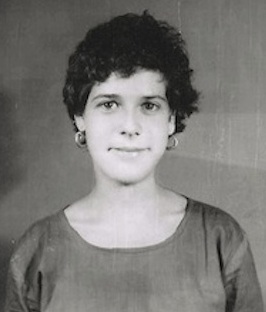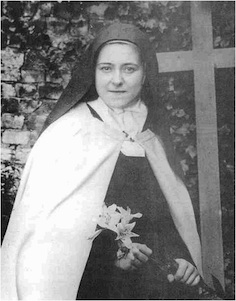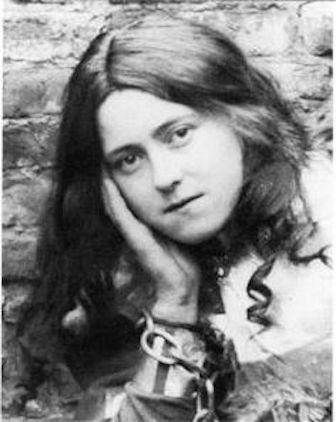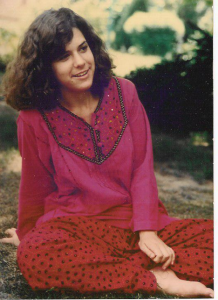Ron’s Memoirs
Beholding Divinity in a Weeping Willow Tree
~ Ron’s Memoirs
“Vision is the art of seeing the invisible.”
~ Jonathan Swift
“It is only with the heart that one can see rightly.
What is essential is invisible to the eye.”
~ Antoine de Saint Exupery
“People think that they see, but they don’t.”
~ Henry Moore
“I saw the angel in the marble and carved until I set him free.”
~ Michelangelo
“True Vision is insight, not eyesight.
Eyesight is mind-sight; insight is soul-sight.”
~ Ron Rattner, Sutra Sayings
“Reality’s essence is Divine luminescence.”
~ Ron Rattner, Sutra Sayings
“There was a time when meadow, grove, and stream,
The earth, and every common sight,
To me did seem
Appareled in celestial light,
The glory and the freshness of a dream.
It is not now as it hath been of yore;
Turn wheresoe’er I may,
By night or day,
The things which I have seen I now can see not more.”
~ William Wordsworth, Intimations of Immortality
“It is only with the heart that one can see rightly.
What is essential is invisible to the eye.”
~ Antoine de Saint Exupery
“People think that they see, but they don’t.”
~ Henry Moore
“I saw the angel in the marble and carved until I set him free.”
~ Michelangelo
“True Vision is insight, not eyesight.
Eyesight is mind-sight; insight is soul-sight.”
~ Ron Rattner, Sutra Sayings
“Reality’s essence is Divine luminescence.”
~ Ron Rattner, Sutra Sayings
“There was a time when meadow, grove, and stream,
The earth, and every common sight,
To me did seem
Appareled in celestial light,
The glory and the freshness of a dream.
It is not now as it hath been of yore;
Turn wheresoe’er I may,
By night or day,
The things which I have seen I now can see not more.”
~ William Wordsworth, Intimations of Immortality
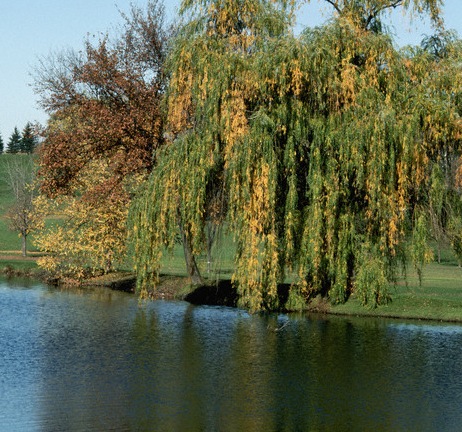
Beholding Divinity in a Weeping Willow Tree
Dear Friends,
In early 1980’s I experienced at Wilbur Hot Springs, an unforgettably revelatory experience of perceiving luminescent Divine light streaming in a weeping willow tree. (*See Footnote) I was attending a week-end Board and staff retreat of the California Institute of Integral Studies (CIIS), as Board Chairman.
One morning I awakened early before any scheduled meetings, and meditated on a wooded hill above the lodge level. After descending I walked with a silent mind on a nature trail near the lodge. Whereupon, I discovered and crawled into a tiny cave where I again sat in deep meditation for a while. (Later, I learned that cave had long been considered a sacred place by original indigenous people there.)
On emerging from the cave, and while unknowingly still in an ‘altered’ state of awareness, I walked to the bathhouse, removed my clothes, stepped outside, and immersed my body in a large shallow hot springs pond.
While standing alone in the stilled pond with a stilled mind, I gazed at a beautiful weeping willow tree beside the pond on the side furthest from the bath house. Instead of seeing the tree as it appeared during usual waking consciousness, I beheld it marvelously transfigured as ever streaming lines of white light, more beautiful than any imaginable Christmas tree.
Unaware of my exceptional state of consciousness, I kept gazing at the tree in awe. After a while Tara, a CIIS staff member, entered the pond. Then, innocently I addressed her: “Tara, look at the lights in that tree. Aren’t they beautiful?” Puzzled, Tara responded “What lights?”. And immediately the lights disappeared for me, as I was abruptly returned to my usual state of waking ‘un-consciousness’.
But I can never forget the flowing tree lights, nor the insight which they confirmed: That there is much more to our “reality” than meets the eye; that “Reality’s essence is Divine luminescence”.
Later that day, I recounted my experience to Dr. John Broomfield, then CIIS President, who cited me to this similar experience of author Annie Dillard:
“[O]ne day I was walking along Tinker Creek thinking of nothing at all and I saw the tree with the lights in it. I saw the backyard cedar where the mourning doves roost charged and transfigured, each cell buzzing with flame. I stood on the grass with the lights in it, grass that was wholly fire, utterly focused and utterly dreamed. It was less like seeing than like being for the first time seen, knocked breathless by a powerful glance. The lights of the fire abated, but I’m still spending the power. Gradually the lights went out in the cedar, the colors died, the cells unflamed and disappeared. I was still ringing. I had my whole life been a bell, and never knew it until at that moment I was lifted and struck.”
~ Annie Dillard, A Pilgrim at Tinker Creek
Like Annie Dillard’s tree vision at Tinker Creek, beholding the transfigured weeping willow at Wilbur Springs was for me an unforgettably inspiring and transformative experience for which I remain ever grateful.
May these and similar stories ever remind us that “Reality’s essence is Divine luminescence”; that we are all Divine beings of light, gradually remembering and co-creating ever more luminous and numinous Earth lives.
And so may it be,
Ron Rattner
Footnote* Other memorable experiences of Divine light, beginning with an epiphany in Yosemite, are recounted elsewhere in these memoirs.
Spirituality, Religion and Politics
~ Ron’s Memoirs
“Those who say religion has nothing to do with politics
do not know what religion is.”
“I claim that human mind or human society is not divided into watertight compartments called social, political and religious.
All act and react upon one another.”
~ Mahatma Gandhi
“Look how the caravan of civilization
has been ambushed.
Fools are everywhere in charge.
Do not practice solitude like Jesus.
Be in the assembly, and take charge of it.”
~ Rumi
“In our age there is no such thing as “keeping out of politics.”
All issues are political issues, and politics itself is a mass of lies, evasions, folly, hatred and schizophrenia.”
~ George Orwell – “Politics and the English Language,” 1946
“When fear becomes collective, when anger becomes collective, it’s extremely dangerous. It is overwhelming… The mass media and the military-industrial complex create a prison for us, so we continue to think, see, and act in the same way… We need the courage to express ourselves even when the majority is going in the opposite direction… because a change of direction can happen only when there is a collective awakening… Therefore, it is very important to say, ‘I am here!’ to those who share the same kind of insight.”
~ Thich Nhat Hanh, The Art of Power
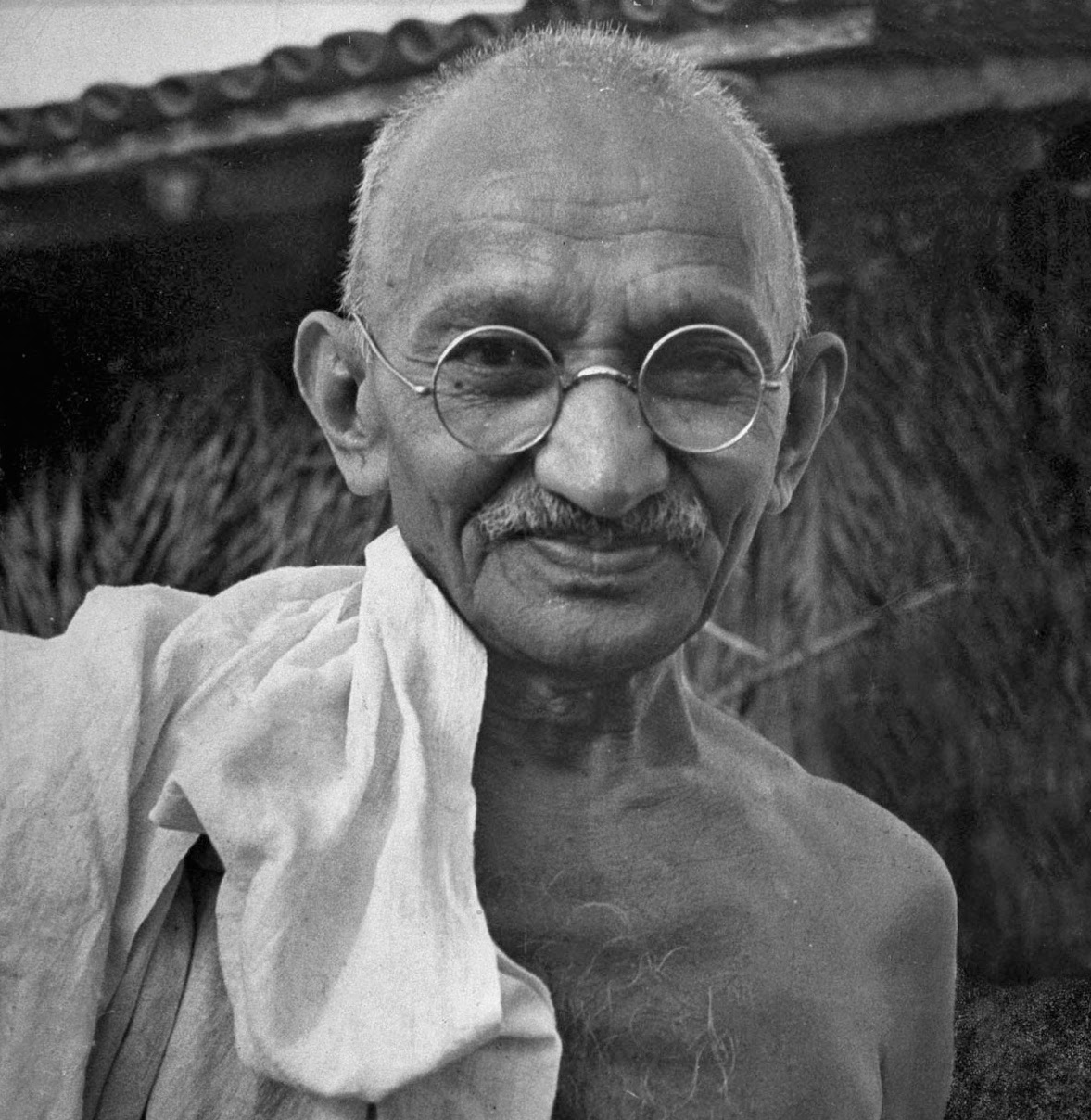
Mahatma Gandhi
Introduction.
After my mid-life spiritual awakening, my lifestyle changed radically. While publicly maintaining my professional life as a lawyer, privately I soon began living a simple monk-like existence, withdrawing from prior involvement in worldly entertainments and pastimes. For the first time in many years, I was living alone without a partner to influence my way of life. So, following inner inclinations, I stopped watching TV and rarely went to movies or concerts. I became a largely raw-food vegetarian and ate mostly at home rather than in restaurants. Retaining very few pre-divorce friends, I spent more time alone and began associating mainly with people interested in spirituality.
And especially after meeting Guruji in 1978, I felt for the first time an intense longing to return to Divinity. So I began praying fervently for a way to exchange my life of litigation for a life of meditation. But I felt confused and conflicted because I needed income from lawyering to help support my young children.
Whereupon, synchronistically I was given an unforgettable mystical experience which helped resolve that confusion. In a crowded courtroom, I was shown that the Divine is immanent in everyone everywhere – even in crafty lawyers; that experiencing nearness to God is mostly dependent on our state of mind rather than our physical environment. (See https://sillysutras.com/beholding-divine-light-in-a-worldly-courtroom-rons-memoirs/ )
So I became resigned to carrying on my life as a lawyer. However, I remained uncertain about continuing my life-long social justice activities when I yearned to devote more quiet time for meditation, prayer and spiritual practices.
Ultimately, after much soul searching, I honored inner impulses and persisted in pursuing an egalitarian path of politically engaged spirituality, rather than a path of monk-like withdrawal from worldly concerns. Though I respected the reclusive spiritual masters, monks and nuns who elevate human consciousness through their spiritual light and devotional practices, I felt greatest affinity with Mahatma Gandhi, Martin Luther King, Jr., Jesus, and the Dalai Lama, whose non-violent pursuit of social justice greatly inspired me.
My Social Justice Politics.
Though neither of my parents was politically engaged, growing up I felt early affinity with traditional Jewish social justice values. The Torah (old Testament) admonishes Jews not just to give to the poor but to advocate on their behalf. For example, Proverbs 31:9 tells Jews to “speak up, judge righteously, champion the poor and the needy.”
So, in becoming a lawyer and throughout my professional career, my main motivation was to help others; it was not to become rich or famous. Long before my spiritual awakening, I had a deep inner instinct to pursue social justice causes, with considerable egalitarian sensitivity to the “insanity and iniquity of inequity in our society”. For many years I symbolically kept on my desk a placard with this inspiring biblical language:
“He shall rescue the needy from rich oppressors,
The distressed who have no protector.
He will have pity on the needy and poor,
And redeem them from oppression and violence.”
~ Psalm 72:12-14
In the late 1950’s I was deeply influenced and persuaded by then prominent author-psychotherapist Erich Fromm, about the pathology of ‘normalcy’ in our materialistic society. In “The Sane Society” Fromm suggested that materialistic Western society was lacking in sanity; that the inequities and disharmonies of the entire society were pathological, not just the mental illnesses of people therein. Like Karl Marx, Fromm saw capitalistic greed and exploitation of workers at the root of societal pathology, and persuasively he advocated for democratic socialism. (Much later I learned that my heroes Dr. King, Albert Einstein and the Dalai Lame held similar views.)
Fromm’s essay confirmed and enhanced my instinctive reluctance to selfishly follow materialistic societal goals. And it encouraged me to endorse egalitarian political and economic solutions for redressing indiscriminate imposition of inequality in our capitalistic society. Often I became quite passionate and outspoken about my political views that “the more that money rules the world, the more that money ruins the world”.
Especially after the traumatically shocking 1963 “deep state” assassination of President John F. Kennedy and the soon ensuing ‘false flag’ alleged Gulf of Tonkin attack as pretense for escalated and patently insane Viet Nam war devastation, I became aware of the prescience of President Dwight Eisenhower’s 1961 valedictory caution against dominance of the “military-industrial complex” with “potential for the disastrous rise of misplaced power”. And ultimately I perceived that, despite Eisenhower’s warning, ruling power had indeed been misappropriated by people who are ruling and ruining the world, in concert with the military-industrial complex or “deep state”, while presiding over serious curtailments of US constitutional protections and civil liberties.
I saw that just as Hitler in Nazi Germany had molded an insane society to support his pathological pretensions and plans, sociopathic Western leaders of all political parties have used insidious propaganda about contrived enemies and fomented “terrorists” as a pretense to create insane societies which have fearfully condoned or acquiesced in outrageously immoral wars in Afghanistan and Iraq, drone killings of innocent civilians, and plans for attacking Iran, Libya, Syria and other Moslem countries, with radically expanded US military budgets and executive powers, while obscenely enriching entrenched vested interests.
Politically Engaged Spirituality.
After my mid-life spiritual awakening, my radical political views persisted. But, inspired by Mahatma Gandhi and others, I sought to ‘spiritualize’ my legal advocacy and social justice pursuits, so as to foster rather than impede optimal evolutionary advancement. Though outwardly little changed, inwardly I more and more accepted challenges of my lawyer’s life as opportunities to fulfill moral responsibilities to society, my clients, my family and others, while elevating my spiritual awareness.
But, especially after inauguration of the Bush/Cheney administration and the terrorist attacks of 9/11/2001 – which (based upon indisputable evidence) I deemed ‘false-flag’ operations perpetrated to foment hatred against intended Moslem targets of the military industrial complex – I became so caught up in polarized political issues that I clearly was experiencing more combative (rajasic) and less elevated (sattvic) energy than before meeting Guruji. However, instead of taking responsibility for my own agitated and combative state of mind, I often complained that Bush and Cheney and deep state ‘neocons’ had ‘brought me down’ from higher states of consciousness.
Gradually, I came to see that it was my own disturbed, judgmental and reactive ego/mind – not Bush and Cheney et al – that was psychologically bringing me down. Thus, I also could see (as Mahatma Gandhi observed) that the human mind and human society are “not divided into watertight compartments called social, political and religious. All act and react upon one another.” And I began viewing apparent injustices with more and more detached compassion for the wrongdoers’ egotistic ignorance – yet never abandoning nonviolent Gandhian pursuit of social justice.
Further, during recent “new normal” global sufferings, I’ve realized that most spiritually evolved people are empathetically awakening with deep concern about resisting and ending current needless hardships caused by unprecedented alleged health edicts fraudulently curtailing normal human activities, and by inequitable and unsustainable human exploitation of vulnerable beings and limited planetary resources insanely initiated by transnationally powerful “leaders” and institutions.
Because our hallowed Mother Earth is now experiencing an Aquarian age of “once-in-a-lifetime” favorable cosmic energies and auspicious cyclical and astrological planetary alignments, and because the Eternal Light of Divine Truth always prevails over malignant darkness, I now optimistically foresee humankind’s imminent “critical mass” empathetic awakening to our instinctive caring for one-another, and ascension to elevated new dimensions beyond current space/time sufferings – wherein we will follow our hearts to co-create a prophesied New Earth era of long-lasting happiness beyond space/time sufferings.
Thus I believe that this is an historically unprecedented pivotal time, when much of humankind will ‘quantum leap’ to lovingly higher states of consciousness and spiritual freedom. And that we are immensely fortunate to witness and cooperatively participate in so raising humanity’s collective consciousness, as – at long last – we return to living life as unseen Source of all we see.
Conclusion and Dedication
Hence my Gandhian political philosophy has helped me experience ever expanding gratitude for this hallowed human lifetime, and to remember and revere the Divine Holiness of everyone, everything, everywhere.
May these memoirs about the politics of spirituality and morality similarly inspire all of us, individually and collectively, to gratefully become ever vigilant and concerned spiritual citizens of our beautiful blue planet Earth. And may we non-judgmentally and forgivingly remember the holiness of all Earth-life, until ultimately we realize that everything’s holy; and, that nothing’s really Real, but Divine LOVE.
In arriving at crucial insights about the politics of spirituality and morality, I received much inspiration from the lives and words of others. A collection of quotations which have especially helped me is now posted at https://sillysutras.com/spirituality-religion-and-politics-quotations-and-sayings/.
And so may it be!
Namasté!
Ron Rattner
Jessica R., Saint Teresa of Lisieux, and the Rose Petal “Miracle”
“There are only two ways to live your life.
One is as though nothing is a miracle.
The other is as though everything is a miracle.”
~ Albert Einstein
“I no longer have any great desires,
beyond that of loving ’til I die of love.”
~ Saint Teresa of Lisieux
“After my death I will let fall a shower of roses…..
I will spend my Heaven in doing good upon earth.”
~ Saint Teresa of Lisieux
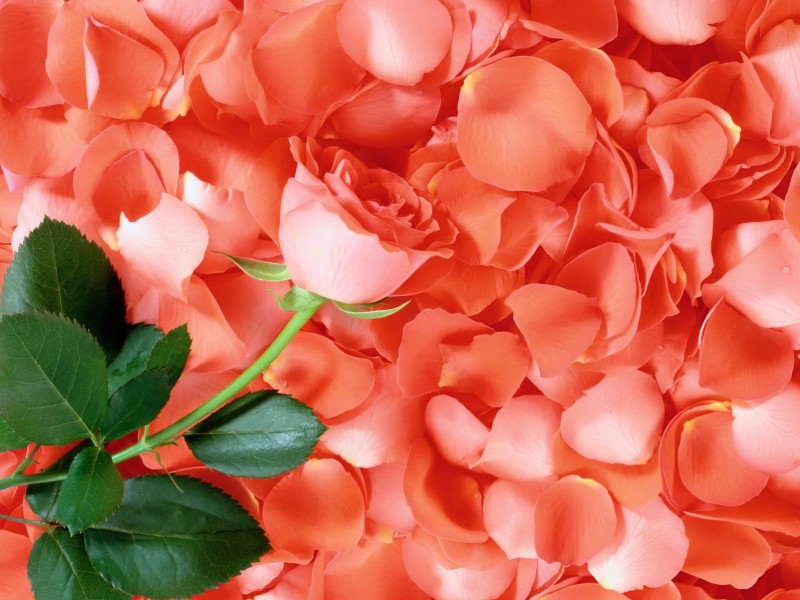
Jessica R., Saint Teresa of Lisieux, and the Rose Petal “Miracle”
On observing noteworthy phenomena which we can’t yet explain by known natural or scientific laws, we call them “miracles” and often attribute them to a Divine power. So some rare mystics and saints allegedly perform “miracles” for the good of humanity, and to foster faith in the Divine. Thus, after “miraculously” healing an official’s dying son, Jesus observed: “Unless ye see signs and wonders ye will not believe.” John 4:48
Here is a story about a noteworthy “miracle” involving my daughter Jessica and a mystery which I haven’t yet solved:
Following my traumatic 1976 divorce I did not share with Jessica and Joshua (my children who were then quite young) my intense new interest in Eastern religious philosophy. However, Jessica later independently became interested in Buddhism during a pre-college high school course in comparative religions. And she maintained her interest as she matriculated as a student at Amherst College, Massachusetts in the 1980’s.
In her 1983 application essay to Amherst, Jessica at age seventeen wrote:
“While I make no claim to being a Buddha –
a true master or enlightened being –
I have begun to understand that I must always be a seeker:
open and receptive to all new people, ideas, and things.
For although I have been extremely privileged
and have had the best possible education,
I haven’t yet and never will stop learning.
Having just recently discovered its spiritual dimensions,
I now know that a world of knowledge awaits me,
diverse and filled with surprises.
Fully aware of its vast potential and wealth,
I feel that I am ready to venture further into it,
and to explore what it has to offer.
‘I who do not know, and know that I do not know:
let me through this knowledge know.’
Idries Shah, The Way of the Sufi”
After her admittance and enrollment at Amherst, Jessica began doubting whether she was receiving there the “best possible education”. Seeking spiritual rather than secular knowledge, Jessica enrolled in and attended a brief accredited Buddhist Studies course in India sponsored by Antioch College. In 1987, after returning from India, she resumed her Amherst studies, and practiced Buddhist Vipassana meditations at a nearby Insight Meditation Society center. During a ten day silent meditation retreat there, she experienced a profoundly transformative spiritual awakening. Thereafter, her dissatisfaction with life at Amherst and her desire to go back to India gradually became so intense that she elected to leave Amherst for India, just one semester short of graduation. (Only after spending many years in India, did she return to complete her Amherst curriculum and post-graduate studies at Smith College.)
In India, Jessica initially spent time with Buddhist monks and practitioners in Bodh Gaya, a shrine where the Buddha was ‘enlightened’, and in Dharamsala, where the Dalai Lama of Tibet lived in exile with a large community of expatriated Tibetans. Then, planning to return to the US, she decided ‘out of curiosity’ to first visit a Hindu ashram in the state of Kerala, Southern India, the home of Ammachi, a renowned woman spiritual teacher. Instead of returning to finish her college curriculum, Jessica was so drawn to Ammachi and ashram life that she elected to live and remain there as a Hindu renunciate for many years. She was given by Ammachi the auspicious sanskrit name “Yogini”, wore only white attire, and contentedly lived the life of a Hindu nun.
While Jessica was living on the ashram in India, I consulted expert Vedic astrologers to interpret her chart or “karmic map”. I was told Jessica had an auspicious spiritual destiny, and that I would some day be “proud of her” spiritual achievements. Especially because of Jessica’s prior transformative meditation experience in Massachusetts, this seemed to me a credible prediction. So, I waited with interest to see what might happen with her.
In May of 1993, Ammachi was scheduled to make a world tour, including a stay at her San Francisco Bay area ashram in San Ramon, CA. And Jessica was to accompany Ammachi as part of her entourage. Jessica’s mother, Naomi, and I eagerly anticipated Jessica’s arrival in the Bay Area. While I continued to be supportive of Jessica’s life in India, Naomi was skeptical about Ammachi and strongly disapproved of Jessica’s life with her. She wanted Jessica to return home to finish her education and lead a “normal” life. Naomi was then living in a Victorian house in San Francisco, with a small raised front porch.
A day or two before Jessica’s scheduled arrival, Naomi awakened one morning with repeated thoughts of Jessica, and irrationally thereby intuited that Jessica was arriving then – early. She came downstairs from her bedroom and opened the front door, thinking that Jessica had arrived. Jessica was not there, but Naomi beheld that her entire front porch was strewn with rose petals of various colors. Since there were no nearby rose bushes, or other apparent explanation for the mysterious appearance of the rose petals, Naomi assumed that someone (probably Jessica’s “born-again Hindu” father) was playing a trick on her. Thereafter, when Jessica arrived as scheduled, Naomi reported to her the manifestation “miracle” of the rose petals.
Soon, Jessica recounted Naomi’s story to Ammachi. On hearing the story, Amachi gathered and handed to Jessica a packet of rose petals and instructed Jessica to give them to Naomi, “so that mother will remember this mother”. Jessica obliged, and on opening the packet Naomi observed that the rose petals from Ammachi were the same colors as those which mysteriously had appeared strewn on her front porch. So, Jessica believed that Ammachi had manifested the rose petals on Naomi’s porch, while Naomi remained skeptical about the incident, thinking it was some trick.
When Jessica told me that Ammachi apparently had graced Naomi with rose petals from “heaven”, I began continuously wondering about that incident. I had never before heard of any such manifestation attributed to Ammachi or any saint. And I wondered why such a special blessing was bestowed on Naomi, who was not a devotee of Ammachi but, rather, one who remained skeptical of Ammachi and her teachings. Also, I wondered why Ammachi would send rose petals to Naomi, rather than giving her some other spiritual experience that might assuage her skepticism and her consequent concern for Jessica’s future.
“Coincidentally” or synchronistically, soon after the rose petal incident, I read for the first time the autobiographical memoirs of Saint Teresa of Lisieux, the patron saint of France, entitled: “The Autobiography of Saint Therese of Lisieux: The Story of a Soul.” Teresa, who became the most popular of modern saints, entered a Carmelite convent at age fifteen and died there of tuberculosis, an unknown young nun, at twenty four. She would have remained unknown to the world but for her memoirs written at the direction of her prioress (in epistolary form) and for three volumes of her letters, all published posthumously.
In reading Teresa’s memoirs I was repeatedly reminded of Jessica. That little epistolary book reminded me of Jessica’s letters – of her way of sharing in writing her feelings about spiritual and inner matters. Also, apart from such syntactical similarities, I just constantly kept thinking of Jessica while reading about Teresa. But in no way did I then connect my repeated thoughts of Jessica, with the manifestation of rose petals on Naomi’s front porch, following Naomi’s repeated thoughts of Jessica. However, that mental/intuitive connection soon happened while I was on vacation in Northern New Mexico, visiting my spiritual author and poet friend Richard Schiffman.
In July, 1993, Richard and I journeyed to a remote Benedictine monastery calIed “Christ in the Desert”, situated in a very beautiful canyon on a wild river. Previously, I had asked Richard and others if they knew of any other examples of rose petal manifestations by saints, like Ammachi’s apparent rose petal “miracle” on Naomi’s front porch. Until then, no one was able to identify for me any such alleged manifestation by Ammachi or anyone else.
Not until my visit to the book shop at Christ in the Desert, did I find what I was seeking. At the book shop I found several books about Teresa of Lisieux, and I told Richard how Teresa’s autobiography had reminded me of Jessica. Thereupon, Richard remembered that Teresa had been associated with rose petal “miracles”; that during her life she often threw rose petals; that during her last illness she had announced: “After my death I will let fall a shower of roses”; and, that rose petal manifestation “miracles” (amongst others) were posthumously attributed to her.
Apparently, those “miracles” together with the publication of Teresa’s autobiographical diaries and letters resulted in such an outpouring of public sentiment that the Vatican “fast-tracked” petitions for her beatification and canonization in a manner unprecedented in modern times. When Teresa died, she was an unknown young nun. But for her writings about her inner life and aspirations, she would have remained historically unrecognized, and she would not have inspired millions of people to her ‘little way’ of spiritual devotion.
On returning to San Francisco from New Mexico, I began reading biographical materials about Teresa, and discovered some noteworthy parallels between Teresa and Jessica. Teresa – like Jessica – was a beautiful, precocious, sensitive and charismatic child to whom people were instinctively attracted. From childhood, Teresa – like Jessica – suffered from depression and other psychological insecurity issues without any apparent cause. Teresa – like Jessica – had hypersensitive hearing. In childhood, Teresa – like Jessica – could be obstinate about her wishes. From an early age Teresa – like Jessica – often showed wisdom and judgment well beyond her years. Teresa – like Jessica – had a simple yet elegant and eloquent way of sharing in diaries and epistolary writings her feelings about spiritual and inner matters.
On the eve of entering the Carmelite convent, Teresa wrote to her sister Agnes: “I want to be saint”, an aspiration which she often reiterated thereafter. In India, after soul searching and wondering about her life’s purpose, Jessica intuited and wrote in her daily journal her answer to that question: “I want to be saint”. (It is difficult to explain from her Jewish background, Jessica’s extraordinary aspiration to be a saint. Also it was surprising to me that Jessica assiduously kept journal diaries throughout her stay in India and prior thereto, a practice not instilled by her parents.)
The biographical materials about Teresa confirmed what Richard Schiffman told me at Christ in the Desert: that throughout her life Teresa loved throwing flowers and scattering rose petals as religious offerings; that shortly before her death Teresa proclaimed, “After my death I will let fall a shower of roses.” “I will spend my Heaven in doing good upon earth.”; and that rose petal manifestations were posthumously attributed to Teresa.
Also, l learned that just after Teresa’s twenty first birthday (January 2, 1894), she abandoned the sloping handwriting style which theretofore had been imposed upon her, and began to write in the way that came naturally to her: upright. In comparing photos of Teresa’s upright handwriting with Jessica’s upright handwriting, I perceived noteworthy similarities. But most noteworthy for me was comparison of photographs of Teresa and Jessica taken at similar ages. I found great similarities in their faces, especially in the eyes. To make sure I wasn’t hallucinating, one Sunday on visiting my beloved Jewish mother, Sue, I showed her a picture of Teresa dressed in nun’s habit, and asked: “Mom does this photo remind you of anyone?” Her prompt reply was: “She looks like Jessica, especially around the eyes.”
Here are the photos of Teresa and Jessica, which I found noteworthy:
By 1995, Jessica had a change of heart about continuing her life as a Hindu nun at Ammachi’s ashram. After much soul searching, she decided that she did not want to spend the rest of her life in India as a nun; that she wanted to finish her US education, marry and have children. And so after spending many years in India – in Bodh Gaya, Dharamsala, and Kerala – Jessica returned to Massachusetts to complete her Amherst curriculum and post-graduate studies at Smith College. At Smith she met and thereafter married David Channer. Their first child, Uma, was born on January 2, 2000, the 127th anniversary of Teresa’s birth on January 2, 1873.
In researching Saint Teresa, I learned that Father Jacques Sevin, a priest who founded the Boy Scouts of France, was one of her early and exceptionally ardent and influential devotees. And I found in his photo on the Internet an unusual resemblance to Jessica’s husband, David. Here are photos of Father Sevin and David Channer which I found noteworthy:


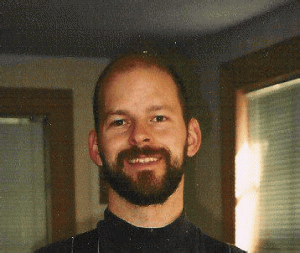
After Jessica returned to Massachusetts, I reported her changed status – from Hindu nun to American householder – to my friend Pravin Jani, father of spiritual teacher Shri Anandi Ma, and expert Vedic astrologer and pundit who had predicted an auspicious spiritual future for Jessica. His brief comment was: “Very good. She needs that experience in this lifetime.”
What does this all mean? Why did it happen? How did it happen?
I don’t know.
Did Ammachi manifest rose petals on Naomi’s porch? If so, why?
Did Saint Teresa? If so, why?
Until now, Jessica hasn’t wanted to even hear or talk about this subject. But for me it raises significant questions not only about the rose petal manifestation mystery, but about prevailing Eastern views on “reality”, afterlife, reincarnation, and evolutionary transmigration of the soul from lifetime to lifetime.
What do you think?
Remember, your thoughts are important:
“We are what we think.
All that we are arises with our thoughts.
With our thoughts, we make the world.”
~ Buddha
© The Perennial Wisdom Foundation – “From Secular Hebrew, to Born-Again Hindu, to Uncertain Undo – An ex-lawyer’s spiritual metamorphosis from Litigation to Meditation to LOVE.”
~ by Ron Rattner
Transmuting Agony to Ecstasy: An Unforgettable Indian Commuter Train Ride ~ Ron’s Memoirs
“The hurt that we embrace becomes joy.”
~ Rumi
“Suffering, cheerfully endured, ceases to be suffering and is transmuted into an ineffable joy.”
~ Mahatma Gandhi
“Acceptance of the unacceptable is the greatest source of grace in this world.”
~ Eckhart Tolle
“Surrender, one could say, is the inner transition from resistance to acceptance, from “no” to “yes.” When you surrender, your sense of self shifts from being identified with a reaction or mental judgment to being the space around the reaction or judgment. It is a shift from identification with form–the thought or the emotion–to being and recognizing yourself as that which has no form–spacious awareness.”
~ Eckhart Tolle
“This is the miracle. Behind every condition, person or situation that appears bad or evil, lies concealed a deeper good. That deeper good reveals itself to you, both within and without through inner acceptance of what is. “Resist not evil” is one of the highest truths of humanity.”
~ Eckhart Tolle
We have nothing to surrender
But the idea
That we’re someone,
With something
To surrender.
~ Ron Rattner, Sutra Sayings

Introduction
In January, 1992, just after my retirement as a San Francisco litigation attorney, I journeyed to India to pay respects to my then one hundred fourteen year old beloved Guruji, Shri Dhyanyogi Madhusudandas, and thereafter to visit my daughter Jessica who – known as “Yogini” – was living an ascetic life on Ammachi’s ashram in Kerala.
During my six week stay in India, I was blessed with many wonderful spiritual experiences with Guruji, and with other holy people and places. But, apart from my brief visit with Guruji, [See https://sillysutras.com/introduction-to-rons-memoirs/] my most memorable and instructive spiritual experience happened unexpectedly on a commuter train to Bombay (now Mumbai).
By that time – sixteen years after my mid-life spiritual awakening – I had already learned from my traumatic divorce that life’s most painful and difficult experiences can prove disguised blessings. Suffering extreme sadness from unexpectedly being separated from my two young children – the most psychologically traumatic time of my adult life – had triggered my spiritual awakening process. A broken heart had opened my heart to new ‘realities’ and sparked a crucial new evolutionary period of spiritual self awareness and self inquiry – a tremendous blessing!
And prior to 1992 I had learned experientially and from many spiritual teachings the importance of spiritual surrender – of giving up imagined control and of letting go to go “with the flow”. For example, during a presumed 1979 ‘near death’ experience, when I mistakenly thought I was dying from a stroke, by watching within without resistance to presumed imminent death, I had an unforgettable inner experience. [ See https://sillysutras.com/my-near-death-experience/ ] But it is much easier to say “go with the flow” or “let go and let God” or “leave it to The Lone Arranger” than to practice that wise advice – especially when you are suffering. Except for very rare beings, like Guruji, we are all in the process of ‘undoing’ and letting go of who we think we are, to thereby realize what we really are – Divinity incarnate.
My Bombay commuter train experience proved an important demonstration of how accepting “what is” can bring great blessings, and how the blessings of letting go of ego, can be triggered by extreme pain and suffering.
Description
Here is what happened:
At the end of January 1992, I flew from San Francisco to Bombay, India [ now Mumbai] with my friends Pundit Pravin Jani, father of Shri Anandi Ma, Guruji’s successor, and Kusuma, Guruji’s former cook and translator. We were also honored to be accompanied by Shri Swami Shivom Tirth, a respected Indian shaktipat guru who, as successor to Swami Vishnu Tirth, headed India’s largest shaktipat lineage with several ashrams. We had known and learned from Swami Tirth for a few years before our trip to India and greatly honored and respected him.
With Pravinji and Kusuma as companions, I planned on visiting Guruji, who was then in Ahmedabad, the largest city in Gujarat State. However, our visit was delayed until after my Indian friends first attended to other personal matters.
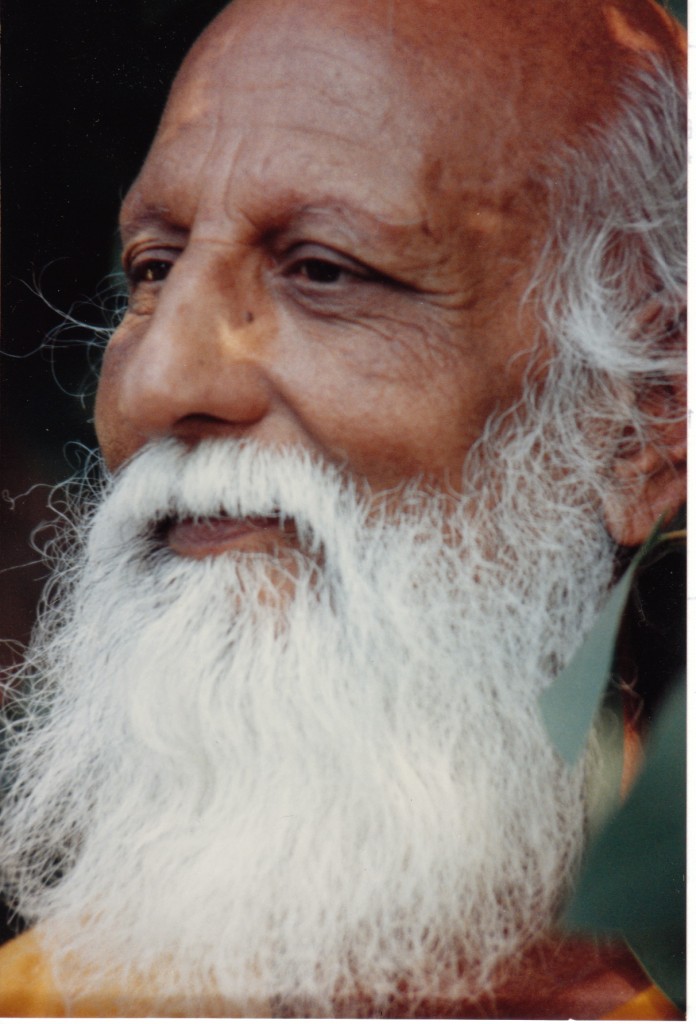
Shri Swami Shivom Tirth
So Swami Shivom Tirth invited me to stay with him at his Bombay area ashram, until I was ready to fly to Ahmedabad. Gratefully, I accepted his kind invitation and was granted the honor and privilege of staying with him in his private quarters, rather than in the general ashram housing area.
Soon after my arrival at the ashram, Swami Tirth told me that he had arranged a special sight-seeing excursion for me to view legendary seventh century Hindu and Buddhist temples in rock-cut caves on Elephanta Island in the Bay of Bombay; that a senior Bombay area swami was to be my guide and companion on the excursion; that I was to meet him – in a few days – in central Bombay, where we would get ferry boat transportation to the island.
At the ashram it was very hot, so I wore light white clothes and sandals, instead of shoes. Before my scheduled tour day I suffered a wound on my left foot, which became infected. Despite first aid, the infection grew and became increasingly more painful. On the day of my scheduled tour I awakened with a very sore left foot. Nonetheless I was determined to see the Elephanta Island caves and relics.
So I walked to a nearby train stop, to catch a morning commuter train into central Bombay where I would meet my Swami tour guide. Instead of wearing sandals which were inappropriate for hiking on the rocky island paths, I was obliged to use shoes. It was a very hot day, with morning temperatures already approaching 100º fahrenheit.
My feet expanded as I walked to the train stop in the heat, and the already painfully infected left foot began aching more than ever before as I reached the train stop. Within fifteen minutes, the Bombay commuter train arrived, and stopped for boarding passengers. But there were no seats, and not even standing room in the vestibule. Yet in order to get to central Bombay on time, I needed to board that train for a forty minute ride.
Somehow I squeezed into the vestibule, which was already so filled with people that there wasn’t even an accessible pole or strap to hold for balance. People were packed in like sardines, and I was virtually unable to move. I stood there in the intense heat with excruciating pain that seemed to have become unbearable. But I could do nothing about it. Whereupon, suddenly and unexpectedly I had a radical change of attitude; I stopped resisting and stopped thinking how terribly I was suffering, and mentally accepted the situation just as it was.
With a surrendered and stilled ego/mind no longer resisting the intense heat, crushing proximity of sweaty human bodies, and excruciating pain, all at once I experienced an extraordinary and unforgettably indescribable state of extreme bliss which persisted for the remaining thirty minute train ride into central Bombay.
Even after that bliss state abated in Bombay, I was able to peacefully enjoy my tour to Elephanta Island because I was no longer resisting the pain in my foot.
Epilogue
The Bombay commuter train experience of transmuting agony to ecstasy has proven an invaluable lesson for this entire precious lifetime. It showed that by giving up and surrendering all we think we are we may gain deep experience and insight of what we really are; that it is in dying to ego life that we are reborn to eternal life; and, that such letting go of ego entity identity is perhaps our ultimate purpose in this precious human lifetime.
Beholding Beings Of Light
~ Ron’s Memoirs
“It is only with the heart that one can see rightly.
What is essential is invisible to the eye.”
~ Antoine de Saint Exupery
“The question is not what you look at, but what you see.”
~ Henry David Thoreau
“Everywhere I look, I see the face of God.”
~ Walt Whitman/Ron Rattner
“I have now come to a stage of realization in which I see that God is walking in every human form and manifesting Himself alike through the sage and the sinner, the virtuous and the vicious. Therefore when I meet different people I say to myself, “God in the form of the saint, God in the form of the sinner, God in the form of the righteous, God in the form of the unrighteous.”
~ Ramakrishna Paramahansa
“Spirituality is very simple.
I am everywhere, says the sage.
I exist in every form of creation.
If I hurt any form, I hurt myself.
If I raise any form to a higher level, I myself, find progress.
It is easy.”
~ Shree Ma
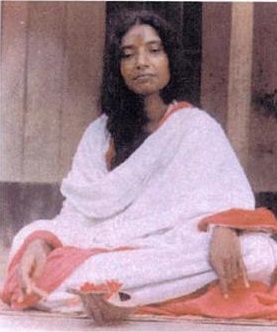
Shree Ma
Beholding Beings Of Light
Dear Friends,
Have you ever beheld strangers as divine beings? This happened to me one beautiful sunny Sunday, in January 1985, as I walked along San Francisco Bay to and from the Golden Gate Bridge. And I can never forget that amazingly inspiring experience.
The previous day and night I had been blessed to spend time with Shree Maa, a saintly and beautiful Hindu spiritual teacher who, with Swami Satyananda Saraswati, had recently arrived from India. They were then staying at a small house in Concord, California, east of San Francisco.
Shree Maa and Swami Satyananda Saraswati were then presiding over extended Navaratri rituals, in homage to the Divine Mother (known to Hindus as Devi, Durga or Shakti). These rituals included a powerful fire ceremony [“yagna”] with appropriate prayers, mantras and offerings to the Divine.
I gladly accepted a friend’s invitation to attend the commencement of these ceremonies in which I fervently joined. Previously, the house in Concord had been owned and occupied by my friend’s dear mother, who had been brutally murdered there by an intruder. We believed that these rituals conducted by saintly beings would help purify lingering negative subtle vibrations from that horrible violence, and bless the departed mother’s soul.
After spending most of the night participating in the ritual fire ceremony, I returned home to San Francisco in an elevated state of consciousness. Unknowingly, after a brief sleep, I awakened the next day still in an elevated state of awareness.
It was a beautiful warm sunny weekend day. So I decided to walk along the Bay to the Golden Gate Bridge. Because we were enjoying exceptionally fine weekend weather, the path along the Bay was filled with many people.
For a couple of hours while still in an abstracted state of awareness, I beheld every person I encountered – dozens, without exception – as a divine being emanating and glowing with Divine luminescence.
Again, with Grace I was given the insight that, beyond normal eyesight, reality’s Essence is Divine Luminescence; that every human is divinity masquerading in a precious human form – a “space-time soul suit”.
Since that unforgettable experience by the Bay, I have from time to time again glimpsed strangers as luminescent divine beings. But never yet again in such a protracted and dramatic way. Nonetheless, almost every meeting with another person has become for me a potential ‘holy encounter’ as I recall our common divine essence and identity.
So, I remain forever grateful for the Grace of that vision of the invisible. And for saintly beings like Sree Maa through whom such Grace manifests.
And so may it be!
Ron Rattner
Meeting Tibetan Buddhists ~ Ron’s Memoirs
“The first preliminary practice consists of recognizing and giving value in its right measure to the precious human existence and the extraordinary opportunity that it gives to us to practice Dharma and to develop spiritually.”
~ Kalu Rinpoche – Foundations of Tibetan Buddhism
“[T]he reality of the world today is that grounding ethics in religion is no longer adequate. This is why I believe the time has come to find a way of thinking about spirituality and ethics that is beyond religion.”
~ H.H. the Dalai Lama – Beyond Religion: Ethics for a Whole World
“In the present circumstances, no one can afford to assume that someone else will solve their problems. Every individual has a responsibility to help guide our global family in the right direction. Good wishes are not sufficient; we must become actively engaged.”
~ His Holiness the Dalai Lama, from “The Path to Tranquility: Daily Wisdom”
![Ven. Kalu Rinpoche [1905—1989]](https://sillysutras.com/wp-content/uploads/Kalu-Rinpoche_0001-642x1024.jpeg)
Ven. Kalu Rinpoche [1905—1989]
Introduction. I have been blessed by meeting and learning from many spiritual teachers, in addition to my beloved Guruji, Shri Dhyanyogi Madhusudandas. Especially inspiring and helpful have been certain Tibetan Buddhist teachers.
Soon after my mid-life spiritual awakening, I was first exposed to Buddhist teachings via radio. For many years, I regularly listened to masterful New Dimensions Radio interviews by Michael Toms of spiritual teachers and authors, often Buddhists. And on Sunday nights, while driving home from visiting my parents, I regularly heard on KPFA recorded talks by Buddhist teacher, Alan Watts, a brilliantly insightful and articulate former Episcopal priest who had ‘converted’ to Zen Buddhism and moved from the UK to Marin County, California. Also for a short time I attended Sunday morning dharma talks and Zazen meditations at the beautiful and bucolic Green Gulch Zen Center in Marin County.
After my 1978 shaktipat initiation by Guruji I mostly focussed on Hindu spiritual teachings. But I remained curious about other spiritual and mystical traditions, especially non-duality teachings which I found not only in Advaita Vedanta, but also in Buddhism, Taoism and Sufism. (Ultimately, beyond religion, I became most focussed on certain universal wisdom principles at the heart of all enduring spiritual, religious, philosophical and ethical paths – like the “Golden Rule”. And to further those teachings I established The Perennial Wisdom Foundation.)
During a 1979 apparent ‘near death’ experience, I had visions of ethereal, luminescent and intricate mandalas – like those associated with Vajrayana Buddhism – which sparked much curiosity about Tibetan Buddhists and their mandalas. Soon afterwards I was synchronistically blessed with darshan of Tibetan lamas who in diaspora had started coming to the West. Most important for me were H.H. the Dalai Lama – who remains a living inspiration for me, and Kalu Rinpoche, a very venerable Tibetan Buddhist meditation master, now deceased and reborn.
For over thirty years I have been deeply inspired by core Buddhist teachings, as practiced by the Tibetans, though I never became a practicing Buddhist. In the 1980’s I honored that inspiration by receiving refuge and taking Boddhisattva vows from Kalu Rinpoche, and by receiving empowerments and teachings from both Kalu Rinpoche and the Dalai Lama, as well as other Tibetan lamas.
Taking Refuge. After meeting Kalu Rinpoche, I soon took refuge from him in the three jewels of Buddhism – the Buddha, sangha and dharma. In a brief refuge ceremony with this great yogi, I thereby symbolically committed to honor the Buddha – as my own true nature – and those teachings and communities which would advance realization of that Buddha nature.
Boddhisattva vows. Shortly after taking refuge I was inspired to take Boddhisattva vows from Kalu Rinpoche to altruistically help all sentient beings end their sufferings.
In taking these vows I was deeply inspired by this selfless Tibetan Buddhist ideal exemplified by the Dalai Lama, Kalu Rinpoche and many other Lamas. Never content with only their own spiritual evolution and salvation, Buddhist Boddhisattvas postpone their own ‘nirvana’ choosing to take continuing rebirths in order to serve humanity until every sentient being has been helped to liberation. For example, His Holiness the 14th Dalai Lama, is latest in a long line of Boddhisattva Dalai Lamas, believed to be manifestations of Avalokiteshvara or Chenrezig, the Bodhisattva of Compassion and the patron saint of Tibet.
Taking Boddhisattva vows symbolically marked an important transition from my prior aspiration to escape through spiritual “enlightenment” from this world of inevitable suffering. Rather than yearning to leave this crazy world forever, I took those vows aspiring to stay here in ways which might help all life everywhere, as I continued to observe and clear my own mental defilements.
Enlightenment as a Process. After taking these Buddhist vows, I didn’t expect an early departure from space/time causality reality. Instead, influenced by Buddha’s teachings that conditioned existence (samsara) has been going on for so long that all beings may have been each other’s parents in some lifetime, I began regarding “enlightenment” as a virtually endless evolutionary process in which – except for Buddhas and Boddhisattvas – we unwittingly participate for eons.
The Tibetan Tulku Tradition. Tulkus are emanations of those who retain spiritual consciousness and continuity through successive births. Except perhaps for rare Buddhas and very evolved beings, on rebirth almost everyone experiences ‘instant amnesia’ about conscious details of other lifetimes and prior spiritual learning, which details remain in our subconscious memory. The Tibetan Tulku tradition, aims to facilitate fulfillment of boddhisattva vows by locating reborn Lamas at an early age and training them from childhood to rekindle their consciousness of Buddhist teachings and practices. Tibetans have elaborate tests to prove that newly reborn Tulkus are truly who the waiting elders think they are, such as checking whether the child can recognize acquaintances or possessions from his previous life or answer questions only known to his former life-experience. For example, this process is portrayed in Kundun, the classic biographical film about the Dalai Lama. Some rare Tibetans (like the Karmapa) are able to foretell before dying where they will consciously take rebirth.
Karma. The Tibetans’ Tulku tradition is inextricably intertwined with their teachings about karma, rebirth, and Boddhisattvas. Although virtually all mystical traditions accept karma, afterlife and reincarnation, the Tibetan Buddhists’ karma and rebirth teachings and their Boddhisattva traditions especially helped me enhance identification with spirit while diminishing my psychological fear of bodily death.
According to Eastern philosophies, Karma is universal law of cause and effect applied at subtle levels to everything we think, do or say during repeated rebirths as supposedly separate beings. A similar concept is implicit in Western teachings that we reap as we sow. [Galatians 6:7-9]
As long as we self-identify as subjects separate from supposed objects of our choice or intention, our exercise of supposed free will creates karmic causes and conditions. Buddhism teaches that karma means “volitional action.” Any thought, word or deed conditioned by samsaric illusion – for example, defilements like desire, hate, or passion – creates karma. On death, the unexperienced effects of karmic causes, result in unavoidable rebirths.
What is reborn? “Reincarnation” is commonly understood to be the transmigration of a “soul” – viz. apparently circumcised spirit – to another body after physical death. But in Buddhism there is no concept of separate soul or individual self that survives death. Yet Buddhists believe in rebirth.
So, what do Buddhists say is reborn to experience karmic causes and conditions, or to fulfill Boddhisattva vows? I will simplistically and metaphorically share my understanding.
I was once told by Swami Sivananda Radha that during a private audience with the Dalai Lama she asked, “In view of Buddhist teaching that there is no separate self or soul, what reincarnates?” And His Holiness replied: “An energy vortex.”
The Dalai Lama’s explanation that an “energy vortex” is what incarnates was consistent with Western science. Since Einstein’s groundbreaking theory of relativity, quantum physicists have confirmed that in this world of space/time and causality everything is energy – every impermanent form and phenomenon, whether or not perceptible or measurable.
And for millennia seers and mystics have revealed that subtle mental energy bodies associated with physical bodies survive death of those physical bodies. Just as computers need an operating system to function, so do physical bodies. Like computers which operate via software, physical bodies are controlled by subtle mind-stuff energies (chitta). And when – like computers – physical bodies inevitably deteriorate and die, their mental software survives, and is reusable.
Thus, just as I am able to use with my new iMac the same OS X software system that operated my old iMac, I can (and may for eons) operate other physical bodies with the same mind-stuff energy that is animating this one. And those other physical bodies which will be using my pre-existing mental software, will probably display many of the same ‘operating features’ as my prior physical bodies. These mental operating systems can be gradually ‘up-dated’. But this usually requires a very slow process of intentional self-discovery and removal of mental obscurations and defilements.
Precious human birth. Before my spiritual awakening, like most other people, I never thought about being human, rather than some other life-form. But after meeting Guruji, I learned that Eastern spiritual paths identify human incarnation as an extraordinarily precious opportunity to evolve – beyond that of any other life-form; that Buddhist and Hindu teachings say that for evolution it is better to be born human than even in a heavenly realm.
Tibetan Buddhist teachings especially helped me realize that human birth is extraordinarily precious and rare. They persuaded me that although the unexperienced effects of karmic causes result in unavoidable rebirths, there is no guarantee that we will evolve on rebirths; that we obtain human bodies because of good deeds in former lives, but that without living compassionately and mindfully with continuing determination to transcend selfish behaviors we squander a rare chance to evolve spiritually.
In October 1982, in San Francisco, I participated together with hundreds of others in a Kalachakra empowerment given by Kalu Rinpoche. In describing the history and rare significance of that ceremony, Lama Kalu explained that our attendance arose from beneficial causes and conditions so mysteriously and statistically rare as to be well beyond ordinary human comprehension – like Jesus’ metaphor of a camel passing through the eye of a needle. For example, according to the Buddha, obtaining a human birth and following truth teachings is as unlikely as it is for a blind turtle to put its head through a single yoke which is cast on the oceans of this world.
In all events, Kalu’s teaching deeply impressed me with the preciousness and impermanence of human birth, and the importance of using it to evolve spiritually.
More memorable experiences with Kalu Rinpoche. Before receiving the Kalachakra empowerment, in 1982 I attended a public talk by Kalu Rinpoche at Fort Mason, San Francisco, about the Mahamudra experience, which he described (through an interpreter) as the quintessence of all Buddhadharma. Though I didn’t understand much of what was said, I intuited that I was in the presence of a great meditation master – like Guruji.
After talking about Mahamudra, Lama Kalu said that to help us understand Mahamudra experience he would give us a brief demonstration of that state of being. Whereupon, with ‘miraculous’ mind-power, he dramatically transformed the energy in that small lecture room. Suddenly my mind went completely still and I experienced a rare state of peace and oneness beyond comprehension or expression. By Kalu Rinpoche’s immense power as a meditation master, he briefly but unforgettably shared with us a glimpse of his rare and exalted state of clear mind.
A few years later, circa 1986-7, I had another memorable experience of Kalu Rinpoche’s powerful presence. Together with my daughter, Jessica, and friends Mark and Marsha Newman, I attended a public talk by him at the San Francisco Unitarian Universalist Church, one of the city’s largest religious sanctuaries. After waiting in a long line for some time, we managed to be seated in pews near the very back of the church.
Just as Kalu Rinpoche had ‘magically’ transformed the energy in the small lecture room where I heard him describe the Mahamudra experience, the energy ambience in that entire large church was palpably transformed upon his appearance at the pulpit. My daughter Jessica, had never before experienced such a spiritually powerful presence and was deeply impressed. Afterwards, she posted a picture of Kalu Rinpoche in her room, and though she never again saw him she was emotionally affected and cried on news of Kalu’s death in May, 1989.
After seeing Kalu Rinpoche at the Unitarian Church, I saw him again when he was interviewed by Michael Toms at the New Dimensions San Francisco radio studio. On his arrival at the studio he was introduced to staff and to me (as a New Dimensions director). Whereupon he came up to each one of us and humbly introduced himself with a friendly handshake. At that gesture, I was impressed with that great yogi’s humility – like Guruji’s. Later I was inspired to observe that: “The more we know we’re no one, the more we’re seen as someone”.
Learning to keep faith despite disillusionment. After many years of questioning, I have found a faith based life – beyond beliefs, dogmas, theologies or personalities. I was very much helped and encouraged in this process by another important and synchronistic encounter with Kalu Rinpoche, at a time of great disillusionment in my life,.
In the 1980’s after Guruji’s return to India I learned with shock that certain private behavior of a spiritual teacher (other than Guruji) with whom I had a close relationship was significantly inconsistent with his teachings and outer image. Though by this time, I knew of numerous instances in which well known spiritual teachers were credibly shown to be flawed humans, like the rest of us. But this was the first time that it happened with a teacher with whom I felt a close rapport and had spent much time. And I was emotionally upset and confused.
Whereupon, I learned that Kalu Rinpoche would be appearing for a morning talk and darshan at Kagyu Droden Kunchab a San Francisco Center dedicated to the ultimate benefit of all sentient beings, which he founded; that his Buddhist teachings would be followed by a question and answer session. I desperately wanted Kalu’s guidance about my crisis of faith. But I had to be in court that morning. So dressed in suit and tie, I came to the darshan with very limited time to spend there.
By the time that Kalu ended his talk, I had only thirty minutes left before needing to leave for court. Whereupon the translator announced that Rinpoche would now entertain questions, and virtually everyone in the room – including me – raised a hand for recognition. ‘Miraculously’ Kalu beckoned first to me to ask my question, which was:
“What is the proper attitude of a student on discovery of a teacher’s behaviors inconsistent with the teachings?”
Whereupon Lama Kalu gave an extremely wise and helpful thirty minute dissertation in response to my inquiry. As soon as he finished and began answering the next question, I was obliged to leave for court. I cannot recount details of what Kalu said, but the unforgettable essence of his answer was:
“Never lose faith in the teachings, even if you lose faith in the teacher.”
Only after years of introspection and more instances of disillusionment with teachers and others upon whom I had mistakenly projected flawless ethics, was I able to fully grasp Kalu’s wise teaching. During that process, I decided that “incarnation is limitation”; that no one is infallible; and, that “it is better to live the teachings, and not teach them, than to teach the teachings and not live them”.
A few years after my last face to face encounter with Lama Kalu, I was memorably reminded of his meditation mastery and his message of faith. On a beautiful week-end day while hiking in the forested higher elevations of Point Reyes National Sea Shore nature reserve, I decided to sit on a rock from which I enjoyed a panoramic view out into the ocean. As I beheld that inspiring nature scene in a meditative mood, Lama Kalu Rinpoche’s smiling visage fleetingly appeared in my inner vision. We never again met in this life, but I shall remain ever grateful for his blessings. With his encouragement I have never lost faith in this precious human life and in the infinite opportunities it affords us.
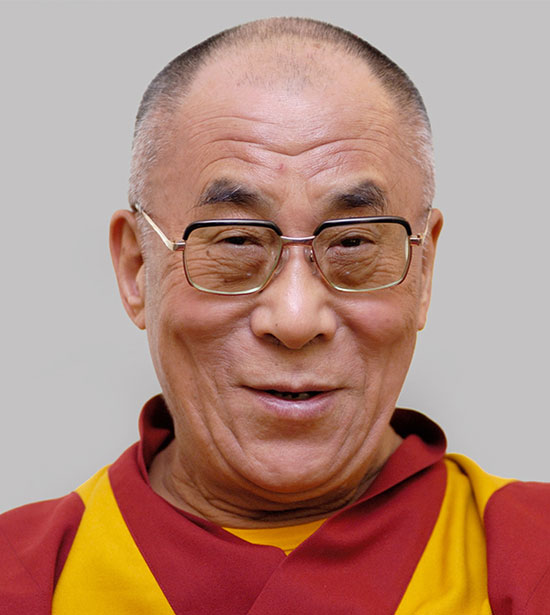
H. H. The 14th Dalai Lama, Tenzin Gyatso.
His Holiness The 14th Dalai Lama, Tenzin Gyatso.
Of all prominent living people, I am most inspired by H.H. the Dalai Lama – the spiritual leader (and former political leader) of Tibet. Apart from his Holiness’s spiritual attainments, which are beyond my comprehension, I am especially inspired by his universal compassion, wisdom, humility and humor.
I see him as a living exemplar of human potential – a Boddhisattva helping countless sentient beings and all life on our precious planet in infinite ways beyond religion or politics. Although my encounters with His Holiness have been impersonal – only as part of large audiences or via videos or writings – I feel a deep connection and harmony with him as a revered fellow human being.
Ever since an October, 1989 darshan, I have wondered whether that harmonious connection began in other lifetimes. At that time, I had the good fortune of being one of a limited number of people privileged to attend a ceremony to be conducted by His Holiness atop sacred Mount Tamalpais in Marin County, in a natural outdoor amphitheater. Because of limited highway access, the Dalai Lama was scheduled to arrive by helicopter. But his flight was delayed, and so we awaited his arrival.
Instead of waiting in the amphitheater, I decided to meditate in a nearby nature place. Then, on contemplating the Dalai Lama I experienced such heartfelt affinity and reverence, that I began an intense and protracted devotional crying jag. I became so overwhelmed with emotion of devotion that I was unable to stop weeping and enter the amphitheater even when I heard the sounds of the helicopter’s arrival. Ultimately, a compassionate Buddhist woman, who on her arrival had observed me crying, came out and taking me by the hand led me, still weeping, into the amphitheater.
The Dalai Lama is the only Tibetan teacher, including Kalu Rinpoche, with whom I have continuously felt such a deep devotional rapport – like my rapport with Guruji. He is regarded by Tibetans as the Bodhisattva of Compassion, and perhaps it is this subtle energy which opens my heart. In all events, though I don’t yet remember another life as a Tibetan, I intuit an important karmic connection with His Holiness, and regard him as a role model for living an ethical and compassionate life, regardless of our religious or cultural history.
Here are some of the ways in which I have been inspired by the Dalai Lama’s life and teachings:
Compassion. In his ever inspiring deportment, talks, and writings, His Holiness manifests and emphasizes the crucial importance of compassionate behavior – even with enemies. Drawing great inspiration from him, I have gradually come to regard everyone I meet – including those with whom I have disagreements – as spiritual siblings – brothers or sisters all sharing the same aspirations for happiness and peace of mind, despite superficial cultural differences. And, despite my pronounced lawyer’s tendencies to combatively judge all adversaries, more and more I have even found compassion for those whose ignorance of their true spiritual identity leads them to egregiously harmful behaviors. For example, at a time when I considered former US President George Bush, Jr., a war criminal and mass murderer, His Holiness publicly described him as “a nice man.” Hopefully, he privately influenced Bush – with whom he shares the same July 6th birthdate – to adopt more compassionate ethics.
Humility. His Holiness is regarded by Tibetans and by many others as a living Buddha. For, example, a Tibetan emigre attending a Tibetan Losar new year ceremony conducted in Minneapolis by His Holiness told a newspaper reporter there that “for Tibetans in exile, seeing the Dalai Lama is akin to Christians getting to meet Jesus”. Moreover, especially since his nomination for the Nobel Peace prize, His Holiness has become like a world-wide rockstar celebrity, attracting capacity audiences for all public appearances. Yet he remains exceptionally humble, describing himself as “a simple Buddhist monk” and member of the Human family. Despite his renown as a living sage, I have heard him several times answering questions with “I don’t know”. In my experience, this is very rare behavior for an elevated Eastern spiritual teacher. For example, I have never heard of any such humble response from elevated Hindu teachers regarded as avatars or ‘god-men’. I was especially drawn to Guruji who (despite his Hindu acculturation) was exceptionally humble, and even told my friend Joy Massa: “follow your heart, even if it contradicts my words”.
I have always felt ambivalent about spiritual teachers who pontificate as if they are infallible. For me, such behavior encourages adulation over inspiration. And I am uncomfortable with any spiritual group or tradition emphasizing adulation of the incarnate over adoration of the Infinite.
In my opinion, selfless humility is a supreme virtue. It is especially rare in prominent people who are subject to great flattery, praise and adulation, which can easily entice and inflate ego, the enemy of compassion and humility. Those like the Dalai Lama, Guruji, Gandhi and Einstein, who have resisted such ego temptations I consider inspiring great beings.
Universal morality and ethics beyond religion. In public talks and in his recently published book “Beyond Religion: Ethics for a Whole World” His Holiness explains how inner values “are the source of both an ethically harmonious world and the individual peace of mind, confidence and happiness we all seek”, concluding that “the time has come to find a way of thinking about spirituality and ethics that is beyond religion” which alone “is no longer adequate”. To me, this is a crucially inspiring message, which completely coincides with my philosophy and life experience. Before publication of “Beyond Religion” I established The Perennial Wisdom Foundation dedicated to elevating awareness of universal principles – like the ‘Golden Rule’ – at the heart of all enduring religious, spiritual, and ethical traditions. And His Holiness’s book and teachings have encouraged me to continue pursuing that path.
Politics, Economics and Ecology. Just as the Dalai Lama’s views on universal morality and ethics beyond religion have paralleled my views and inspired and encouraged me to pursue them, His Holiness supports liberal political, economic and ecological views with which I have long identified and pursued as a social justice advocate.
He recognizes as “a very great thing” Mahatma Gandhi’s sophisticated political implementation of ahimsa – the ancient moral teachings of nonviolence and non-injury. As an engaged Buddhist, the Dalai Lama outspokenly endorses Gandhian non-violent and compassionate political social action benefitting the majority of citizens, especially those underprivileged and exploited.
Thus, he rejects capitalist economics, as focussed on greed, gain and profits and outspokenly endorses democratic Marxist theory of equitable access to means of production and distribution of wealth. But, he rejects as lacking compassion and encouraging class hatred the so-called Marxism of the failed totalitarian former USSR, or China, and he objects to their excessive emphasis on class struggle.
Ecologically the Dalai Lama recognizes that Earth is severely threatened by ignorant human greed and lack of respect for all life on our precious planet. Accordingly, he urges that we become actively engaged as a global human family to resolve this crisis with compassionate solidarity, not just as a matter of morality or ethics but for survival of life as we know it. (See e.g. Spiritual People in a Perfectly Crazy World)
Conclusion. Thus I am supremely grateful for the wisdom and inspiration bestowed by Tibetan teachings and teachers, especially through His Holiness The 14th Dalai Lama, Tenzin Gyatso, who for me is a living exemplar of human potential – a Boddhisattva helping countless sentient beings and all life on our precious planet in infinite ways beyond religion or politics.
Other Teachers: Mata Amritanandamayi [Ammachi] ~ Ron’s Memoirs
“Crying to God for five minutes is equal to one hour of meditation.”
“The state that we attain by calling and crying to God is equal to the bliss that the yogi experiences in samadhi.”
~ Mata Amritanandamayi (Ammachi)
“The fruits of the inner man begin only with the shedding of tears.
When you reach the place of tears,
then know that your spirit has come out from the prison of this world
and has set its foot upon the path that leads towards the new age.”
~ Saint Isaac of Nineveh
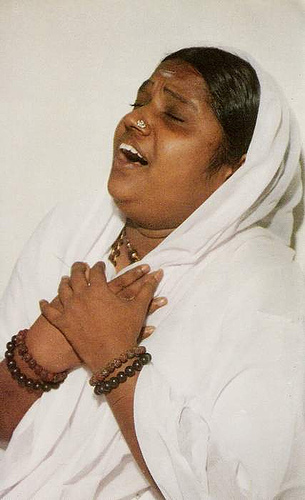
Mata Amritanandamayi
Introduction.
After receiving shaktipat from my venerable Hindu Guru, Shri Dhyanyogi Madhusudandas (Guruji), I entered a new life phase as a devotional “born-again Hindu”, and for many years thereafter I faithfully followed Guruji’s kundalini maha yoga practices. But, especially after Guruji returned to India in 1980, I synchronistically met and spent memorable time with other spiritual teachers, in addition to Guruji’s successor, Shri Anandi Ma, while always maintaining my heartfelt inner relationship with Guruji – above all other teachers.
So in writing these memoirs, as requested by Guruji, it is appropriate that I tell you about some of these other teachers.
Elsewhere I have described my 1982 India pilgrimage experiences, including my darshan with Sathya Sai Baba. I told how Sai Baba hit my head three times uttering ”Enough!” ”Enough!” ”Enough!” while I was crying uncontrollably; that I was left in a state of confusion about my pronounced devotional crying tendencies. (see https://sillysutras.com/darshan-of-sathya-sai-baba-rons-memoirs/)
My confusion about crying for God lingered until it was memorably dispelled years later during darshan of another well known spiritual personality – Mata Amritanandamayi or Ammachi – now known for hugging millions of people worldwide.
Here’s what happened.
Crying Darshan With Mata Amritanandamayi [Ammachi].
After returning from the 1982 India pilgrimage I occasionally meditated at the San Francisco Sai Baba Center. Early in 1987 Timothy Conway, a friend and former president of that center, called asking if I would host at my apartment a program about an Indian woman spiritual teacher, Amritanandamayi or Ammachi, who was then largely unknown in the US. He explained that Ammachi would soon be making her first US visit, and that a small group of her devotees from India were seeking a San Francisco venue for an advance promotional program about her; that as a favor to them he was calling me since Sai Baba Center rules precluded holding the program there.
At that time I was living in semi-seclusion and had hosted no large gatherings in the seven year period since Guruji left my apartment. Guruji was eternally enshrined in my heart, but I remained open to learning from other spiritual teachers. So I hosted at my high-rise hermitage the first San Francisco public program about Amritanandamayi, at which some of her earliest devotees shared films and stories about Ammachi’s unusual history and devotional path. One of them, Neal Rosner (Nealu), Ammachi’s first Western male disciple, had just published a memoir which I acquired and read.

Ammachi’s Earliest Close Disciples
I learned then that Ammachi had been an abused child of an Indian fisherman’s large family in a remote and primitive village in Kerala; that after constantly calling and crying for the Divine, she had manifested many extraordinary spiritual tendencies and that, ultimately she had become a noteworthy trance channel displaying Krishna and Kali energies or moods (bhavas) to the enthrallment of villagers and visitors, some of whom – with her encouragement – had begun considering her a saint or avatar.
Thereafter, on Ammachi’s arrival in the Bay area, I attended one of her first public darshans at which I unforgettably learned about her devotional path of crying for God. Unknowingly I had been following that path since my spiritual awakening. (see https://sillysutras.com/kundalini-crying-for-god-and-other-kriyas-rons-memoirs/ )
By that time I’d become a spiritual friend of pundit Pravin Jani, father of Guruji’s successor Shri Anandi Ma. Pravinji had moved with his family from Bombay to Berkeley, and together we attended an Ammachi darshan at a small house in Oakland. On our arrival, the darshan room was filled with others and there was little remaining seating room. So we sat in a far corner of the room behind the elevated throne-like chair where Amma was receiving visitors with hugs and compassionately answering their spiritual questions.
As I sat in that warm spiritual ambience I experienced a heartfelt meditative state, and tears began trickling – not ‘torrentially’ but steadily. On observing Amma hugging each person who approached her, I felt content to sit and savor that devotional environment, with tears constantly seeping from my often closed eyes. But I was not inspired to go up up for a hug.
After so sitting for some time without intending to approach Amma, one of her attending swamis came and aroused me from my meditative state, quietly saying “Mother asks that you come up for darshan.” Respectfully, I complied with that request, anticipating a quick hug and, perhaps, some blessed fruit (“prasad”). But that is not what happened.
Instead, while lovingly embracing me in her arms and then in her lap, with my tears still seeping, Ammachi gave an extended discourse on the evolutionary importance of crying for God. (Her words spoken in Malayalam were translated by a swami.) After perhaps twenty minutes she concluded her talk referring to me still in her embrace, saying: “If you can cry like him, you’ve won the spiritual sweepstakes.”
The Path of Tears.
Dramatically encouraged by Ammachi, I never again doubted the immense blessing of my spontaneous devotional longing and crying for the Divine. And with curiosity sparked by Ammachi’s discourse, I later found similar teachings from other spiritual teachers in various traditions. (see https://sillysutras.com/the-emotion-devotion-crying-for-god/ ) Especially resonant were teachings of nineteenth century Indian holy man Shri Ramakrishna Paramahamsa, with whom I had developed inner rapport after my unforgettable 1982 deja vu experience at his Dakshineswar residence place.
Ramakrisha, who had cried torrential tears for the Divine Mother, taught:
“[I]f you weep before the Lord, your tears wipe out the mind’s impurities of many births, and his grace immediately descends upon you. It is good to weep before the Lord.” – “Devotional practices are necessary only so long as tears of ecstasy do not flow at hearing the name of Hari. He needs no devotional practices whose heart is moved to tears at the mere mention of the name of Hari.”
After receiving shaktipat initiation from Guruji and the spiritual name “Rasik” – “One engrossed in devotion”, I had continuously kept yearning and often spontaneously calling and intensely weeping for the Divine. So, encouraged by Ammachi, Ramakrishna and others I was much attracted to Ammachi’s path of heartfelt singing and calling to the Divine, and was strongly motivated to see her again. And I did.
Years of tears with Ammachi.
For the next seven years after that first darshan I saw Ammachi during her bi-annual visits to the US and, in her absence, I often attended meditation programs at her nearby San Ramon ashram. Also, on my retirement, in February 1992 for several weeks I visited Ammachi’s Kerala, India ashram, since my daughter Jessica was then an ashram resident known as “Yogini”.
Though often I cried intensely for the Divine at Ammachi’s darshans, unlike most others there I usually was not motivated to receive her hugs. But in her presence I enjoyed marvelous devotional meditations, with tears, laughter, singing, and occasional spontaneous dancing to Amma’s bhajans. Thus through Ammachi I received bountiful blessings for which I am eternally grateful.
Prelude to a new life era.
At first I experienced an exceptionally powerful devotional ambience around Ammachi. And I was much moved by her soulful singing of bhajans calling to the Divine. However, my experience of devotional blessings around Ammachi and my enthusiasm for her darshans gradually diminished and eventually ended in distressing disillusionment.
After a while there seemed to be less and less pure heartfelt energy coming to me from her music and her presence. Ultimately it seemed that the music degenerated from being powerfully authentic to almost banal.
And as Ammachi attracted more and more followers, I perceived a growing cult of personality and materialistic atmosphere around her which greatly agitated and offended my pronounced egalitarian inclinations and aversions to spiritual organizations emphasizing “adulation of the incarnate” over “adoration of the Infinite”.
Also, though initially I always had felt energized by Ammachi’s darshan environment, after a while subtle energies there were more and more flowing from me, rather than to me. So, unlike my experience with Guruji, I was sometimes enervated rather than elevated after Ammachi darshans. This was especially noteworthy when I visited Ammachi’s Kerala ashram in 1992.
Moreover, I ultimately learned of private behaviors associated with or sanctioned by Ammachi which contradicted and belied her outer image and public pronouncements, and which so greatly disturbed me that I began regarding her as a flawed or false guru and not as a purported divine incarnation or avatar. (see Epilogue)
But like my traumatic marriage dissolution, the traumatic dissolution of my faith in Ammachi has proven to be a great disguised blessing which sparked an important new transformative life phase of reliance on inner rather than outer authority. (see e.g. my essay “I’ve Found A Faith-Based Life”)
Epilogue.
Because I spent seven important years at Ammachi darshans I feel obliged to write about those years in fulfillment of my obligation to Shri Dhyanyogi, my beloved guru, who requested that I write and publish my spiritual memoirs.
Until now I have been reluctant to publicly share my distressing disaffection with Ammachi and her organization. I did not wish to discourage other devotees with different perspectives, some of whom are friends. But I now feel morally impelled to tell my truth, with the intention of helping others who might learn from my experience.
Moreover, I feel morally impelled to share elsewhere my observations which support credibility of a recently published critical book about Ammachi.
Gail Tredwell (aka “Gayatri” or “Swamini Amritaprana”), who for twenty years was Ammachi’s revered first and closest Western female devotee, has just published a memoir entitled “Holy Hell, A Memoir of Faith, Devotion and Pure Madness” containing many shocking but credible revelations.
Some of Gail’s revelations are consistent with my observations and corroborate an incident which was my “last straw” with Ammachi, to be explained in another memoirs chapter. Moreover, some of her credible revelations are so shocking that I feel they should be seriously considered by those who may be contemplating relationships with Ammachi and her organization, or with other hierarchical religious or spiritual organizations.
As a long-time former litigation attorney deeply dedicated to social justice and with skills in evaluating credibility of witnesses, I read Gail’s book, initiated extended phone conversations with her, and discussed her allegations with other yet anonymous witnesses. I have found Gail to be a sincere, honest and accurate percipient witness.
Nonetheless, the MA Centers organization has attacked Gail’s character by asserting that she is “a troubled individual” whose writings are “completely untrue and without a basis in fact or reality”. Since I am quite convinced that Gail’s memoirs are absolutely true, I find deeply offensive an ad hominem attack on her by those to whom she selflessly dedicated much of her adult life, and I feel dharmically impelled to support Gail’s credibility.
Meeting Mother Meera ~ Ron’s Memoirs
“Even avatars have to desire to be in God in every moment.
And when avatars die, they desire with all their being to be united with God. …..Look at Ramakrishna. How much he wept and prayed for the Divine Mother.”
~ Mother Meera to Andrew Harvey, “Hidden Journey”, Page 236
“’The visions that come from the Divine change you.
A real vision brings adoration of the Divine,
and in that adoration there can be no vanity. “
~ Mother Meera
“When you know that you are eternal,
you can play your true role in time.
When you know you are divine
you can become completely human.”
~ Mother Meera
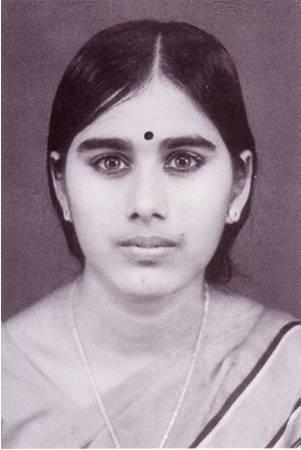
Mother Meera
Introduction.
After Guruji returned to India in 1980, I remained open to learning from other spiritual teachers. From my experience with Guruji, I had learned that ‘sitting at the feet of a master’ can be quite auspicious. Thus though Guruji encouraged initiates to follow only his Kundalini Maha Yoga path, he didn’t discourage us from seeing other teachers. Once he told my friend Joy Massa, “I’ve learned from many teachers, why shouldn’t you.” So after meeting Guruji I met and learned from many other teachers.
Beginning in 1987, I was especially attracted to the devotional path of Amritanandamayi (Ammachi) of calling and crying to the Divine, and for seven years I attended many of her US darshans and regular programs at her San Ramon ashram. (See https://sillysutras.com/other-teachers-mata-amritanandamayi-ammachi-rons-memoirs/) But while drawn to Ammachi’s devotional path, I continued meeting other spiritual teachers. One of the most memorable was Mother Meera.
Learning of Mother Meera.
In 1991 I listened on New Dimensions radio to Andrew Harvey, masterfully interviewed about his spiritual teacher, Mother Meera, by my friend Michael Toms. I learned that Mother Meera was a young Indian woman who Harvey convincingly portrayed as an alleged avatar of Divine Mother channeling Divine Light (Paramatman). So I became quite curious about Mother Meera, and read “Hidden Journey, A Spiritual Awakening”, Harvey’s book eloquently describing her. Also, at that time a trusted spiritual friend told me of his very profound inner experiences with Mother Meera, which enhanced my interest in her.
Then, in January, 1992, just after my retirement as a San Francisco litigation attorney, I journeyed to India to pay respects to my then one hundred fourteen year old beloved Guruji, Shri Dhyanyogi Madhusudandas, and thereafter to visit my daughter Jessica who – then known as “Yogini” – was living an ascetic life on Ammachi’s ashram in Kerala.
While I visited Ammachi’s ashram, my curiosity about Mother Meera was heightened. I learned that Ammachi had dramatically required that all ashram library books about Mother Meera be removed and burned. So I wondered whether Ammachi regarded Mother Meera as a false ‘avatar’? Also, whether Ammachi was competitive with Mother Meera and other spiritual teachers and, if so, why? (* See footnote)
Meeting Mother Meera.
Later in 1992, on returning from India, I decided to journey to Italy to honor Saint Francis of Assisi, with whom I long felt deep inner rapport. On learning that Mother Meera had moved from India to Germany where she gave darshans at a small town near Frankfort, I decided to fly to Europe via Frankfort, and scheduled several days in Germany before flying to Italy.
So, in July, 1992, I traveled to Thalheim, Germany, where I had three powerful evening darshans with Mother Meera unlike any others I had experienced. In an atmosphere of total silence she blessed each devotee, one by one, with a seemingly unchanging expression. As each devotee would kneel before her in complete silence, she gently held their head in her hands for a few moments. Then, as instructed, each devotee sat up as she gazed into their eyes. We were told that during this ritual Mother Meera was clearing blocks and sharing divine light.
On the first of three nights, while awaiting my turn to approach Mother Meera, I started spontaneously crying and swaying. Whereupon her companion Adilakshmi asked me to be still. (Apparently, she didn’t want me to disturb the silent meditators.) As I awaited my darshan turn, it felt to me as if a gigantic Divine Presence was channelling light through an earthly female form, wherein no one was ‘at home’. I didn’t perceive any heavenly light shows, but I did experience a tremendous and almost palpable yet extraordinarily subtle energy unlike any other I could remember. So much energy was being radiated from her eyes that at times I distinctly felt her eyelids move, even when I was seated at the back of the darshan room filled with up to 200 other people.
Especially on the third night, on gazing into Mother Meera’s eyes, I felt as if I had received an immense blessing, but I have no words to describe it. Friends in the audience reported that the energy in the entire room seemed to change while she blessed me that night.
Outwardly Mother Meera’s darshans were very different from Ammachi’s darshans. There was not a single word or sound or smile that I perceived from her during the entire visit. Unlike Ammachi, Mother Meera didn’t overtly seem to encourage devotees to fall in love with her form. Everyone – including Andrew Harvey, who was there that weekend – seemed to get the same impersonal expression and the same darshan time.
Although I was extremely grateful for the blessing of my darshans with Mother Meera, I did not feel devotionally drawn to her as had happened with Ammachi.
Back To Ammachi.
I planned my 1992 pilgrimage to Assisi to coincide with Ammachi’s world tour appearance there. So after seeing Mother Meera in Germany I traveled to Assisi where – as well as communing with beloved Saint Francis – I attended two Ammachi darshans. (See https://sillysutras.com/pilgrimage-to-assisi-communing-with-saint-francis-rons-memoirs/) Also, I was able to briefly see my daughter Jessica who was traveling in Ammachi’s entourage.
In contrast to the silent Mother Meera satsangs attended by no more than two hundred people, there were up to fifteen hundred people attending Ammachi’s Assisi programs, with a carnival-like atmosphere that troubled me, and I was told there were even bigger crowds in France. Also, I learned to my distress that in preparing the large Assisi spiritual venue for Ammachi some of her devotees had covered up pictures of other spiritual teachers which were on permanent display there.
Nonetheless, I had blissful experiences during the Ammachi darshans, where spontaneously I sang, and swayed, and cried to the Divine. During those darshans Jessica/“Yogini” was seated next to Ammachi – happily handing her flowers. Afterwards Jessica reported to me that one day Ammachi had pointed at me singing, swaying and crying, saying: “Ananda!”
Despite my mounting concerns about a growing atmosphere around Ammachi of adulation of the incarnate rather than adoration of the Infinite, I still felt much more resonant with Ammachi’s devotional path than with the austere silence of Mother Meera’s darshans. So – though gratefully I honored and respected Mother Meera – I never again attended her darshans, but continued seeing Ammachi.
Footnote.
*Ultimately, in 1995-6, I learned that Ammachi was competitive with Mother Meera and other teachers in a manner which was contrary to teachings of Guruji, Ramakrishna, and other teachers I respected. The “last straw” incident which sparked my realization of Ammachi’s competitiveness traumatically ended my faith in her as a teacher. It involved another acclaimed Indian Divine Mother avatar, Shri Amma Karunamayi and is confirmed in the recently published memoir of Gail Tredwell (aka “Gayatri” or “Swamini Amritaprana”), who for twenty years was Ammachi’s revered first and closest Western female devotee. (See “Holy Hell, A Memoir of Faith, Devotion and Pure Madness”, pp. 264-6 )
.
From Mata Amritanandamayi to Amma Shri Karunamayi ~ Ron’s Memoirs
“… if someone is supposed to propagate the Dharma and their behavior is harmful, it is our responsibility to criticize this with a good motivation. This is constructive criticism, and you do not need to feel uncomfortable doing it. In “The Twenty Verses on the Bodhisattvas’ Vows,” it says that there is no fault in whatever action you engage in with pure motivation. Buddhist teachers who abuse sex, power, money, alcohol, or drugs, and who, when faced with legitimate complaints from their own students, do not correct their behavior, should be criticized openly and by name. This may embarrass them and cause them to regret and stop their abusive behavior. Exposing the negative allows space for the positive side to increase. When publicizing such misconduct, it should be made clear that such teachers have disregarded the Buddha’s advice. However, when making public the ethical misconduct of a Buddhist teacher, it is only fair to mention their good qualities as well.”
~ Dalai Lama, Ethics in the Teacher-Student Relationship, 1993
“Can a guru who displays jealousy and competition toward other spiritual leaders help seekers? Such behavior shows that the personality aspects, each with its own ego, are still in control.”
~ Swami Sivananda Radha, “In The Company of The Wise”, page 190
“Do not believe in anything simply because you have heard it.
Do not believe in anything simply because it is spoken and rumored by many.
Do not believe in anything simply because it is found written in your religious books.
Do not believe in anything merely on the authority of your teachers and elders.
Do not believe in traditions because they have been handed down for many generations.
But after observation and analysis, when you find that anything agrees with reason and is conducive to the good and benefit of one and all,
then accept it and live up to it.”
~ Buddha

Shri Amma Karunamayi
Introduction.
After Guruji returned to India in 1980, I met and learned from many other teachers. Beginning in 1987, I was especially attracted to the devotional path of Amritanandamayi (Ammachi) of calling and crying to the Divine, and for seven years I attended many of her US darshans and regular programs at her San Ramon ashram. (See https://sillysutras.com/other-teachers-mata-amritanandamayi-ammachi-rons-memoirs/)
But while drawn to Ammachi’s devotional path, I continued meeting other spiritual teachers. Through my interest in Ammachi, I met Shri Vijayeshwari Devi another memorable Indian female teacher known as Amma Shri Karunamayi who like Ammachi is revered by some devotees as an avatar or embodiment of divine mother. I met Karunamayi under surprising circumstances which ended my relationship with Ammachi and sparked an important new transformative life phase of increasing reliance on inner rather than outer authority. (see e.g. my essay “I’ve Found A Faith-Based Life”)
Learning of Amma Shri Karunamayi.
In 1995, my trusted friend Richard Schiffman – a talented spiritual poet, author and mainstream journalist – who I had met at an Ammachi program in New Mexico after he had lived many years in India – told me by phone that Amma Shri Karunamayi a female Indian spiritual teacher considered a Divine Mother avatar had recently visited New York and other US areas for the first time. He said that many Ammachi New York devotees had been greatly impressed by Karunamayi, and that some wanted to help her organize future US tours. From Richard’s description of Karunamayi, I felt a strong desire to see her, so I asked Richard to keep me informed of her schedule.
Synchronistically, just after Richard told me about Karunamayi, I received two letters from friends in India, telling how they had just spent a month with Karunamayi in Bangalore. They said she is “quite special [and] incredibly gentle and soft and radiates a beautiful and loving presence”, and that “many miraculous stories [are] attributed to her”. They recounted some of those stories, and reported that because Karunamayi was college educated with a focus on meditation (and not hugging) she attracted some more sophisticated devotees than the devotionally adoring people often attracted to Ammachi.
In March 1996, I again received a synchronistic phone call concerning Karunamayi, this time from another spiritual friend, who – like Richard and my friends in India – was also an Ammachi follower. Until then I was unaware that she knew of Karunamayi. So I was quite surprised when my friend asked if I could suggest some Bay Area place where Karunamayi and her entourage could stay in a few months during their first Bay Area visit. Only then did my friend disclose that she had met Karunamayi in Seattle in 1995 where she had offered to host Karunamayi’s first Bay Area visit in 1996.
Also, my friend credibly explained that Ammachi’s New York devotees had received an ‘edict’ from Ammachi – which I later confirmed – against helping or seeing Karunamayi; that she had changed her mind about hosting Karunamayi based on “personal considerations”, and because she felt disharmony with Karunamayi’s national organizers who were aggressively putting undue time pressure on her.
With compassion for my friend’s dilemma, and motivated by a sense of injustice about Ammachi’s ‘edict’ against Karunamayi, I offered to make inquiries about possible San Francisco places where Karunamayi’s entourage could reside and give public programs. But, I explained that since I was living a reclusive life in a small apartment I could not offer to personally host Karunamayi’s large entourage.
Thereupon, my friend called the national organizers for Karunamayi, “resigned” as Bay Area sponsor, and gave them my phone number as a San Francisco contact who might look for appropriate venues. Without consulting me, the Karunamayi national organizers then “conscripted” my services by distributing national flyers with my phone number as their San Francisco organizer.
Despite my displeasure with that involuntary “conscription” as a Karunamayi organizer, I did not – like my friend – tell the national organizers to ‘take me out of the loop’. My sense of compassion and justice inhibited me from leaving Karunamayi without help in the Bay Area. So I decided to help Karunamayi while seeking others who would replace me as Bay Area organizer. Thereupon my daily regime of solitary meditation and prayer and walking in Nature was significantly changed as I made and received phone calls, wrote letters and inspected possible darshan halls.
Though I never located a replacement Karunamayi sponsor, I found several friends who agreed to help. A recently widowed friend who lived alone in a very large Presidio Heights residence agreed to house Karunamayi’s entourage, and to allow morning public gatherings there. Another friend agreed to answer all telephone inquiries about Karunamayi’s schedule. And my dear friend Bina Chaudhuri – widow of Dr. Haridas Chaudhuri, with whom she had co-founded the California Institute of Integral Studies (CIIS) and the Cultural Integration Fellowship (CIF) – arranged for Karunamayi’s evening programs to be held in the lovely CIF main hall.
Meeting Karunamayi.
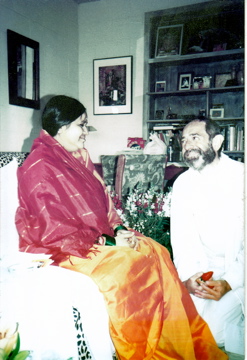
Ron with Karunamayi
As Karunamayi’s first San Francisco sponsor, I was privileged to have various private discussions with her. I learned that like Ammachi Shri Vijayeshwari Devi had no lineage or guru, but that her mother had been a devotee of Shri Ramana Maharshi, who was told by Ramana when pregnant that she would give birth to Devi [“the Mother”]. Just short of college graduation, Karunamayi had retreated to a remote forest where she spent ten years in solitary rigorous practice. Like Guruji, and consistent with her extraordinary early sadhana, Karunamayi’s emphasis was on meditation. Her presence evoked for me moods more meditative than devotional, and inspired my poetry about silence. (see e.g. https://sillysutras.com/in-silence-sweet/) Like Guruji she apparently perceived my subtle auric field. Most memorably she once told me that: “Dhyanyogi has greatly helped you in ways you can not yet know.”
She did not insist that devotees have only one guru.
Once as I was driving Karunamayi and Swami Vijashwarananda – her cousin and Telugu/English interpreter – to the beautiful Marin County Vedanta retreat center, the Swami asked: “Mother wants to know what you eat?” In response I told him: “I eat mainly raw fruits and vegetables, nuts and seeds, and rice and beans.” Whereupon the Swami interpreted my words for Karunamayi, who laughed and replied in Telugu. Then Swami said to me: ”Mother says you’ve eaten like that for many lifetimes.”
Unlike Ammachi, Karunamayi repeatedly encouraged devotees to seek company of other spiritual teachers, as well as to meditate regularly.
The “last straw” with Ammachi.

All my helper friends – like me – were Ammachi followers, but none of us felt conflict with Ammachi since Karunamayi’s San Francisco visit was scheduled for August when Ammachi would not be here. Though my sense of fairness was severely shaken by Ammachi’s New York ‘edict’ against Karunamayi, for a while I suppressed those feelings, along with my long suppressed concerns about a commercialized cult of personality around Ammachi, and the Mother Meera book burning incident. So at first that edict did not quite become “the last straw” in ending my faith in Ammachi.
That happened only after I learned of defamatory gossip and rumors about Karunamayi attributable to the Ammachi organization. Especially after I had met and was blessed by Karunamayi, and was experientially convinced of her authenticity as a spiritual master, I became deeply offended by these false and scandalous rumors, and motivated to help her as an ‘anti-defamation’ attorney.
For many years one of my daily Hindu practices from Guruji was recitation of the Hanuman Chalisa – a poetic ode to the legendary monkey-god Hanuman by poet-saint and philosopher Tulsidas. Though when I met Karunamayi my daily Chalisa practice had lapsed, Karunamayi saw the Hanuman Chalisa in my subtle field and, during a ceremony atop sacred Mount Tamalpais in Marin County, she spontaneously asked me to recite it as part of the ceremony.
Serendipitously, I had just received by mail from my friends in India a beautiful printed version of the Hanuman Chalisa. In a letter to them acknowledging that gift, I wrote:
“Slanderous rumors about Karunamayi originating at the ‘Kerala cuckoo compound’ have strongly activated my justice vasanas [propensities].” — so I wish to — “help as Her self-appointed anti-defamation lawyer. The Chalisa venerates Hanumanji as ‘the protector of saints and sages’, and after many years of recitations, I’ve assimilated some of that energy.”
So, despite my gratitude for the many devotional blessings I had received in Ammachi’s presence, after several years of growing but suppressed concerns about an ‘adulation of the incarnate’ rather than ‘adoration of the Infinite’ atmosphere around her, and about my diminished energy at her satsangs, my realization of Ammachi’s apparent jealousy and competition toward Karunamayi, Mother Meera and other teachers proved “the last straw” in my relationship with her.
Moreover, this realization traumatically brought to my consciousness the long-suppressed awareness that naively and mistakenly I had been projecting perfection onto Ammachi, rather than seeing her as a limited human being; that in adulating Ammachi I was misperceiving my own best qualities. This sudden ‘perfection projection realization’ triggered an important new transformative life phase of increasing reliance on inner rather than outer authority, which I will recount in other memoirs chapters.
(*see footnote)
Epilogue.
For many years I have been reluctant to publicly share my disaffection with Ammachi and her organization. I did not wish to discourage other devotees with different perspectives, some of whom are friends. But I now feel morally impelled to share my observations which support credibility of a recently published critical book about Ammachi, by Gail Tredwell (aka “Gayatri” or “Swamini Amritaprana”), who for twenty years was Ammachi’s revered personal attendant, and first and closest Western female devotee. Her memoir entitled “Holy Hell, A Memoir of Faith, Devotion and Pure Madness” contains many shocking but credible revelations, including reference to Ammachi’s ‘edict’ against Karunamayi (at pages 264-266).
Unable truthfully to attack the credibility of Gail’s memoir about Ammachi, the MA Centers organization has attacked Gail’s character by asserting that she is “a troubled individual” whose writings are “completely untrue and without a basis in fact or reality”, and by instigating and publishing false and defamatory rumors and on-line blog posts about her, while asserting meritless libel claims to intimidate others against commenting on or republishing Gail’s sincere perspectives.
Since I am quite convinced that Gail’s memoirs are true and sincere, I find deeply disrespectful and offensive such an ad hominem attack on her by those to whom she selflessly dedicated much of her adult life. Just as I felt impelled to assist Karunamayi against defamatory rumors, I now feel dharmically impelled to support Gail’s credibility.
Footnote.
* In further memoirs I will tell how – like some other Westerners without any guru tradition – I was naive about Ammachi and other limited or flawed Eastern teachers onto whom I mistakenly projected purported perfection and infallibility, rather than seeing them as limited humans though perhaps further evolved in spiritual awareness. And, I will recount how while faithfully revering my beloved Guruji, and while remaining grateful for blessings received from all my spiritual teachers – including Ammachi – I more and more began relying on inner rather than outer authority; and how whimsically I told friends that I had been transformed from “Born-again Hindu” to “Uncertain Undo”; from Gurubhai to ‘Guru bye bye’.
To karmically repay those few teachers I’ve forsaken in this life, in my next incarnation I may become an insurance underwriter/salesman specializing in custom coverage for spiritual teachers called: “Perfection projection protection”.
Darshan of Sathya Sai Baba ~ Ron’s Memoirs
“There is no liquid like a tear from a lover’s eye.”
~ Rumi
“Crying to God for five minutes is equal to one hour of meditation.”
“The state that we attain by calling and crying to God
is equal to the bliss that the yogi experiences in samadhi.”
~ Mata Amritanandamayi (Ammachi)
Tears are the solution
for dissolution
of other
into Mother –
Mother of All,
Mother of Mystery.
~ Ron Rattner, Sutra Sayings
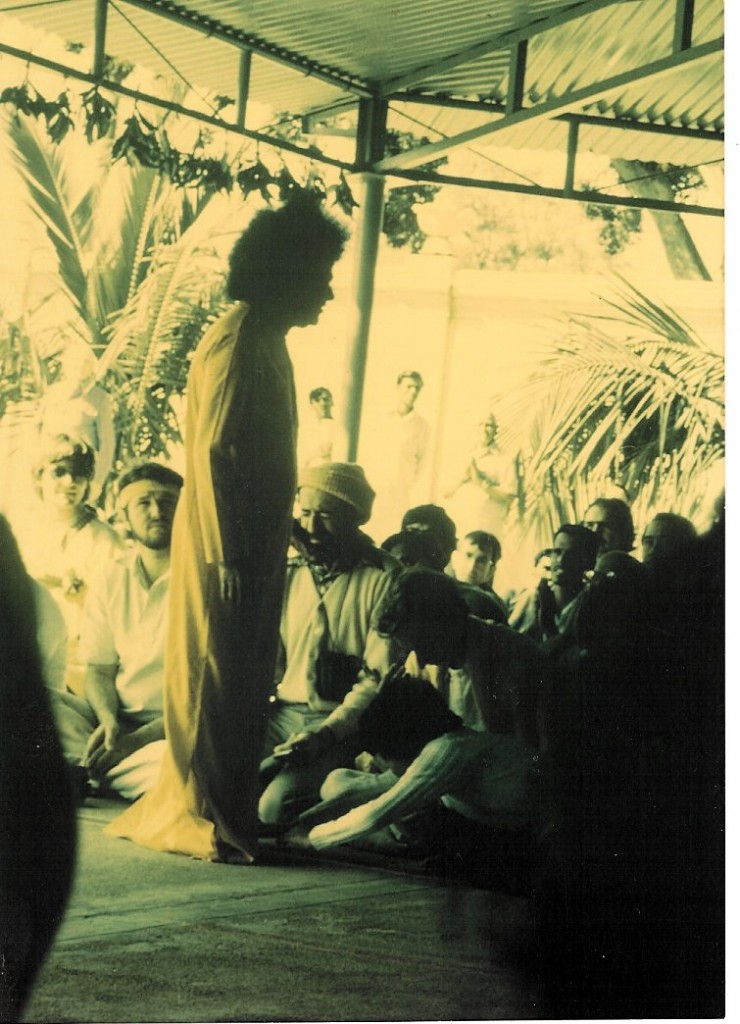
Sai Baba blessing Ron – Bangalore, 1982
In January and February 1982, four years after receiving shaktipat from my beloved Guruji, Shri Dhyanyogi Madhusudandas, and with his approval, I journeyed on a wonderful spiritual pilgrimage to Japan and India led by Sant Keshadavadas, another Indian guru.
On embarking for India I wanted to learn about Indian spiritual culture and its many saintly beings, other than my beloved Guruji. And I was very curious about how I could best advance my quest for “enlightenment” – my spiritual “sadhana”.
During that marvelous guided pilgrimage tour I had numerous unforgettable spiritual experiences from which I learned much. Thus, the journey became and has remained the most important trip of my lifetime. So I am recounting some highlights in these memoirs.
At the time of our pilgrimage, one of the few living Indian gurus of whom I’d previously heard was Sri Sathya Sai Baba, who was the claimed reincarnation of Shirdi Sai Baba, a legendary saint who had died in 1918. I synchronistically learned about Sai Baba shortly before our tour departure on meeting an ardent Swedish devotee, Carin, who was in San Francisco en route to seeing him India.
Carin said that Sai Baba was renowned for his extraordinary powers (siddhis)* [see footnote].And she recounted to me many amazing stories about Sai Baba – of miraculous materializations, healings, clairvoyance, bilocations, and alleged omniscience – including her own experience of his appearing to her in Sweden in a vivid vision and beckoning her to visit him in India. And I learned from Carin that Sai Baba had millions of devotees worldwide, even though he had never left India, except for one trip to Africa. So I became quite curious about Sai Baba and wished to but didn’t expect to see him in India.
Sai Baba usually resided at his main ashram at Puttaparthi, India, and our pilgrimage itinerary did not include any planned visit there. But Carin told me that Sai Baba had a large ashram in Bangalore at Whitefield, where he occasionally visited. Our tour was scheduled to be in Bangalore for three days. So on Carin’s departure for an extended stay at Puttaparthi, I gave her our tour itinerary and she promised to call me in case Sai Baba might visit his Whitefield ashram when we were in Bangalore. I didn’t think that would happen. But synchronistically it did.
Shortly after our tour group checked into the luxurious Hotel Ashoka in Bangalore, I received a phone call from Carin telling that Sai Baba would be giving public darshan at Whitefield the next Monday morning – when fortuitously we had open time. Carin promised to pick me up in a taxi very early Monday morning to assure our finding space at Whitefield, and she suggested that I bring any other interested tour members. Thereupon I arranged for my friends Ramdassi and Tara, and Tara’s friend Pat, and a few others to join us.
Before dawn on Monday, February 1, 1982, Carin arrived at our hotel as promised. And together with my friends and other tour companions we went by taxi to Whitefield for Sai Baba’s darshan. En route, Carin suggested that we ask Sai Baba for a private audience, since he sometimes granted such last minute requests to spiritual pilgrims.
I immediately agreed, hoping to ask Sai Baba how I could best advance my quest for “enlightenment” – my spiritual “sadhana”. So Ramdassi artistically wrote an audience request for me to show him, if possible.
Although Sai Baba didn’t later grant a private audience, I had with him one of the most memorable darshan experiences of my life. Here is what happened.
On arrival at the Whitefield ashram, we were guided to a large canopied outdoor area next to the ashram building. There, we awaited Sai Baba’s appearance with hundreds of others who were already sitting side by side in numerous rows. Women and men were seated separately. I was seated near the end of the men’s darshan area furthest from the portal through which the Swami would later appear.

Ron meditating at Sai Baba Ashram, Bangalore 1982
Soon I went into a deep meditation and lost track of time. But even from that state, I was aroused and opened my eyes on sensing Sai Baba’s immense shakti field as he emerged from the ashram and entered the darshan area. With spontaneous emotion of devotion, I began weeping intensely.
Through my tears I could glimpse Sai Baba slowly walking up and down the aisles of aspirants. Though he looked at each person he did not stop at anyone – until ultimately he reached me.
Whereupon, Sai Baba stopped in front of me. With extraordinarily beautiful eyes he intently gazed at me as I was crying uncontrollably and wondering how to further my “sadhana”. Then he hit me on top of the head three consecutive times with his right hand, each time uttering only one word:
”Enough!” ”Enough!” ”Enough!”
With these hits on the head, I experienced a remarkable infusion of “shakti” energy.
Then Sai Baba soon left without stopping anywhere else. On his departure, I was left highly “enshakticated”, but in an unprecedented state of confusion.
It seemed that in exclaiming ”Enough!” ”Enough!” ”Enough!” Sai Baba had admonished me to stop crying. But that would have been completely inconsistent with my devotional path (bhakti) which strongly encourages and stresses the importance of crying for God.
Though my confusion about the meaning of Sai Baba’s darshan persisted for many years, I did not – and could not – stop weeping for God with emotion of devotion. And gradually I became confident that Sai Baba was not discouraging my gift of tears; that, rather, he was encouraging and blessing me to at long last ‘say sayanara to samsara’.
Epilogue
Since my unforgettable darshan with Sai Baba, the universe has given many messages and hints that Sai Baba’s exclamation
”Enough!” ”Enough!” ”Enough!”
was not an admonition to stop or limit spontaneous devotional crying.
The first of these messages happened later that same Monday in Bangalore. Our previously scheduled afternoon tour activities were cancelled at the last minute. So we were given unexpected free time. Thereupon my friends Ramdassi, Tara and Carin and I decided to visit the beautiful Bangalore temple of Shiva Bala Yogi, a reputedly powerful God Realized shaktipat guru who was previously unknown to us.
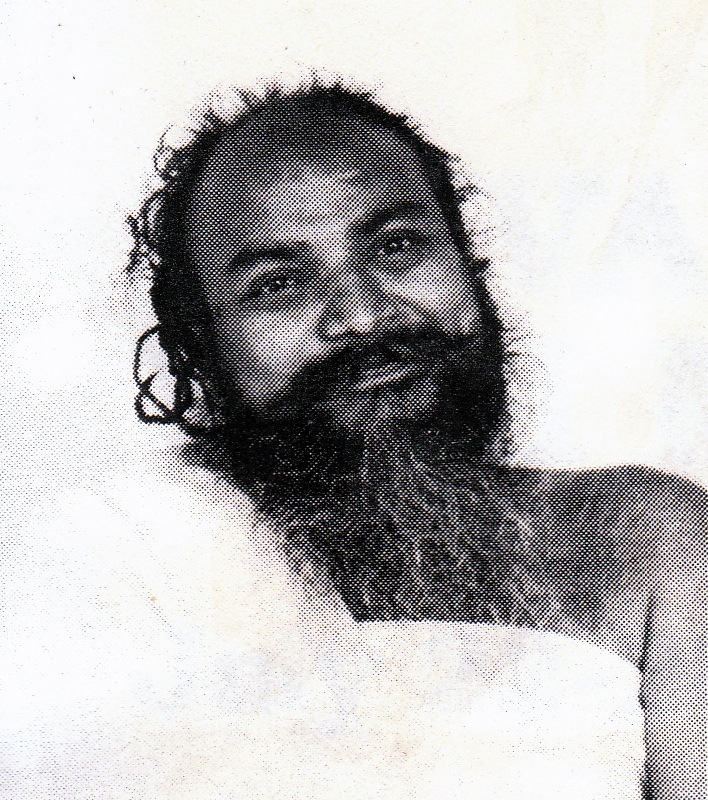
Shiva Bala Yogi
Fortuitously, on our arrival at his temple, Shiva Bala Yogi was there giving darshan – and even answering written questions from spiritual aspirants. So, still “enshakticated” from Sai Baba’s three hits on the head, I asked Shiva Bala Yogi the question I hadn’t been able to ask Sai Baba:
“What should I do for my sadhana?”
He replied, simply:
“Do what you are doing.”
And so I did.
**[see footnote]
Soon afterwards, I received another memorable message from Sai Baba. The next day, Tuesday, our tour departed Bangalore, which was in the center of India, and we flew westward to Mangalore near the Arabian Sea. There we were lodged at an oceanside beach resort. Awakening early Wednesday morning, I decided to jog on the beach before our scheduled activities for that day. Whereupon, I had an unforgettable reminder of Sathya Sai Baba and a possible hint about the meaning of his darshan.
While jogging by the ocean with a stilled mind, I suddenly perceived that I was surrounded and completely enfolded by the body of Sai Baba; that my entire physical body was totally enveloped by the subtle body of Sai Baba. Later I took that unique experience as a metaphoric reminder and symbolic portent that we are as but cells in the body of the Divine with which we will inevitably merge, after we’ve had “enough” worldly suffering.
Footnotes
* Patanjali’s renowned Yoga Sutras, describe yogic powers which may be attained through control of life-force energies. But Patanjali warns aspirants against premature use of of such powers prior to God union, as possibly raising egotistic obstacles to attainment of the spiritual goal. Only after being irrevocably established in God union may the yogi employ powers, without karmic consequences. Especially after Sai Baba’s death in 2011, his frequent display of siddhis became controversial, with various claims that they were sometimes not used for Divine purposes. Also, there were other allegations of questionable conduct.
Despite these allegations, I remain convinced that Sai Baba’s darshan blessed and helped me. In hitting me on the head three times he imparted a tremendous infusion of divine shakti; and his concurrent admonition ”Enough!” ”Enough!” ”Enough!” was probably a blessing helping me to use that precious life force energy to transcend all remaining worldly attachments with inevitable suffering of which I’d had “enough”.
**A month later, I asked Guruji the identical question, “What should I do for my sadhana?” Guruji answered it differently, but unforgettably. See https://sillysutras.com/a-long-but-short-guruji-satsang-story-rons-memoirs/
